
Wye House, Talbot County, Maryland, ca. 1787. (Photo, Gavin Ashworth.)
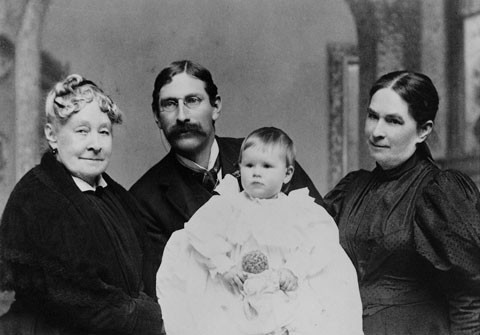
Circa 1896 photograph showing (left to right) Elizabeth Phoebe Key Howard, Charles Howard Lloyd, Joanna Leigh Lloyd, and Mary Lloyd Howard Lloyd.
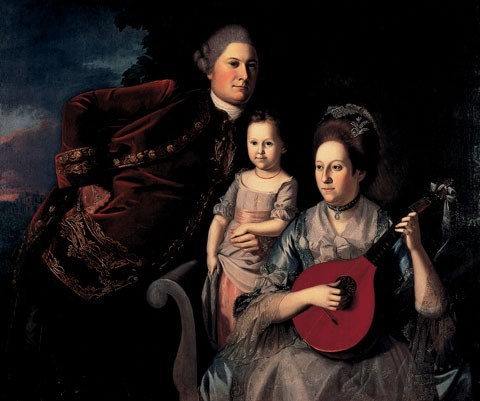
Charles Willson Peale, The Edward Lloyd Family, Maryland, 1771. Oil on canvas. 48" x 57 1/2". (Courtesy, Winterthur Museum.)
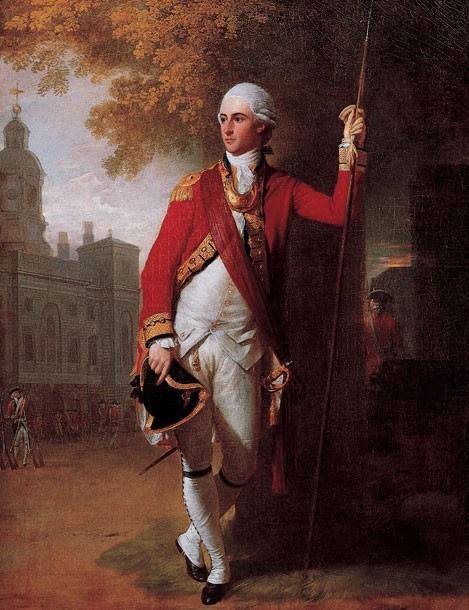
Benjamin West, Richard Bennett Lloyd, London, ca. 1773. Oil on canvas. 36" x 28". (Photo, Gavin Ashworth.)
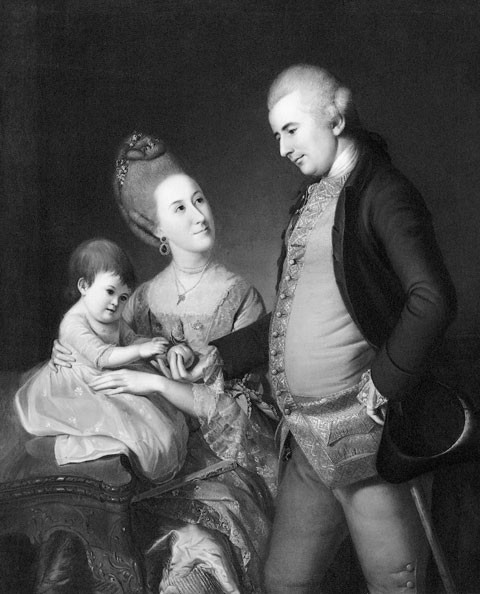
Charles Willson Peale, The Family of John Cadwalader, Philadelphia, 1771. Oil on canvas. 51 1/2" x 41 1/4". (Courtesy, Philadelphia Museum of Art.)

Upholstered armchair, England, ca. 1760. Walnut with beech. H. 37 3/4", W. 28 1/4", D. 23". (Photo, Gavin Ashworth.)

Tall clock case, probably Easton, Maryland, ca. 1790. Walnut with tulip poplar, yellow pine, and oak. H. 91", W. 19", D. 10". (Photo, Gavin Ashworth.) The movement is by Daniel Quare and Stephen Horseman of London and dates about 1715.
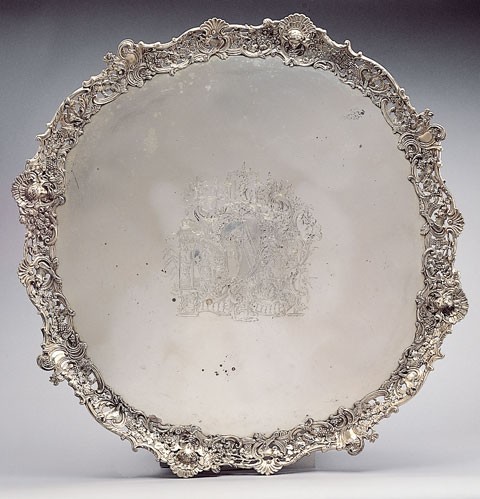
Salver by Jacob Marsh, London, 1754. Silver. H. 3 1/2", Diam. 28". (Photo, Gavin Ashworth.)
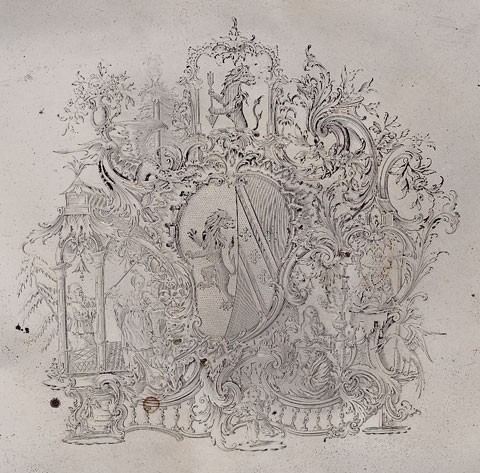
Detail of the engraving on the salver illustrated in fig. 8.
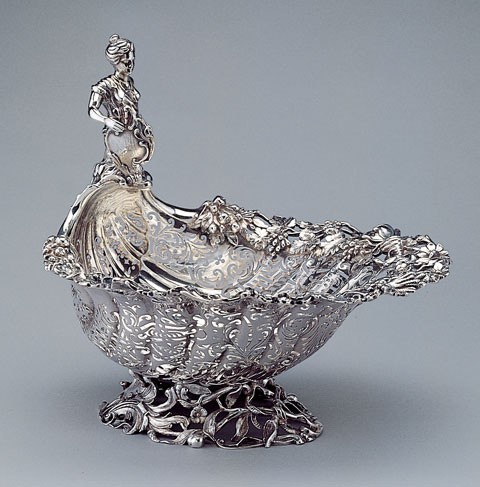
Bread basket by John Wirgman, London, 1754. Silver. H. 12 1/2", L. 13 1/2". (Photo, Gavin Ashworth.)
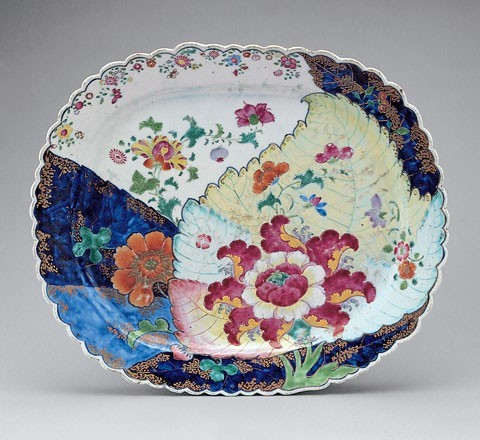
Platter, Chinese export for the British market, 1755–1760. Porcelain. 18" x 15". (Photo, Gavin Ashworth.)
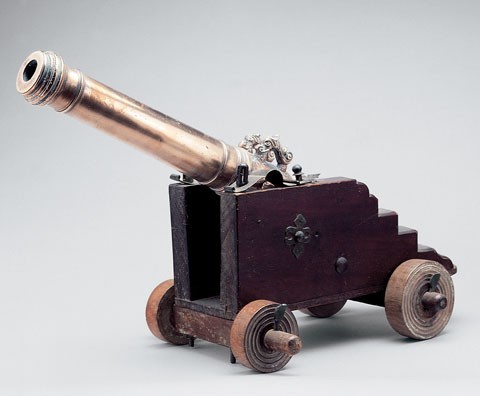
Cannon, England, ca. 1720. Bronze, iron, steel, and wood. L. 26". (Photo, Gavin Ashworth.)

Coat-of-arms of the Lloyd family, England, ca. 1785. Watercolor on paper. 12 3/4" x 15 3/4". (Photo, Gavin Ashworth.)
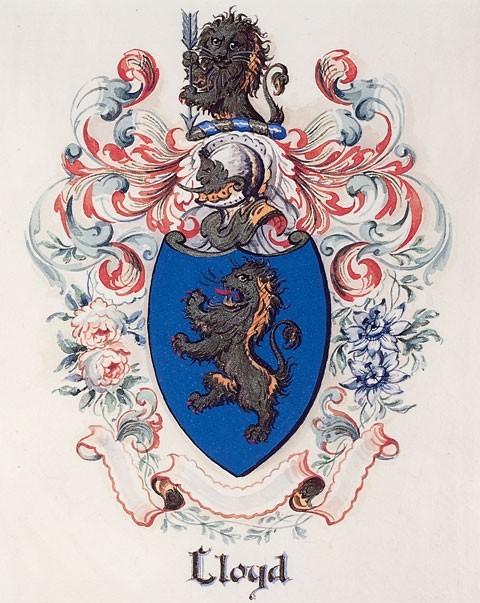
Coat-of-arms of the Lloyd family, England, ca. 1785. Watercolor on paper. 9 3/4" x 7 1/2". (Photo, Gavin Ashworth.)
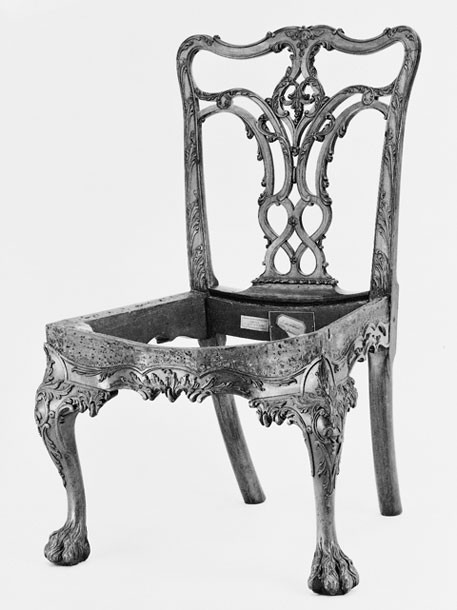
Side chair attributed to the shop of Benjamin Randolph, Philadelphia, Pennsylvania, ca. 1769. Mahogany with white cedar. H. 36 3/4", W. 21 3/4" (seat), D. 17 7/8" (seat). (Chipstone Foundation; photo, Hans Lorenz.)
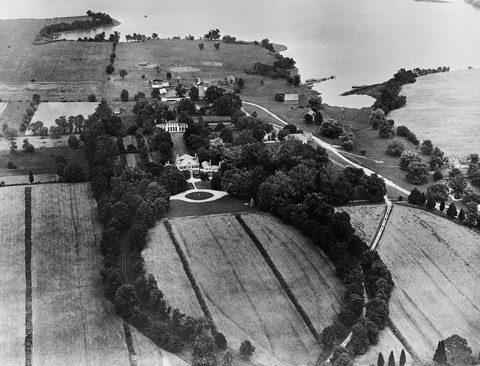
Circa 1935 photograph showing part of the Wye House estate. The house, gardens, and greenhouse are oriented on a north-south axis.
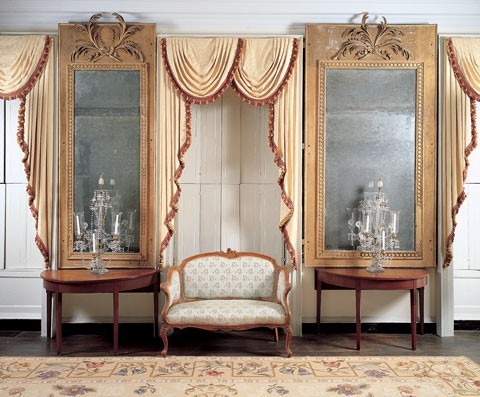
Pier glasses, London, ca. 1755. Woods not identified. Left: H. 104" (not including appliqué), W. 41 1/2". Right: H. 104" (not including appliqué), W. 56 3/4". (Photo, Gavin Ashworth.)
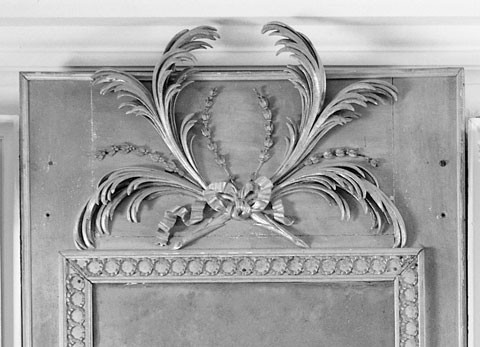
Detail of the appliqué and guilloche on the left pier glass illustrated in fig. 17.
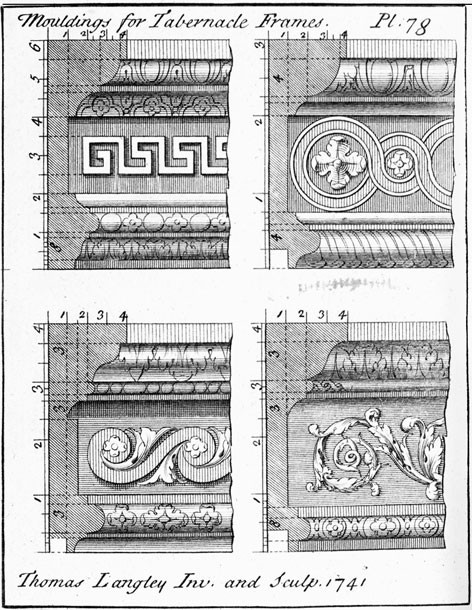
“Moldings for Tabernacle Frames” illustrated on pl. 78 of Batty and Thomas Langley’s The Builder’s Jewell, or Youth’s Instructor (1741). (Courtesy, Winterthur Museum Library: Printed Book and Periodical Collection.)
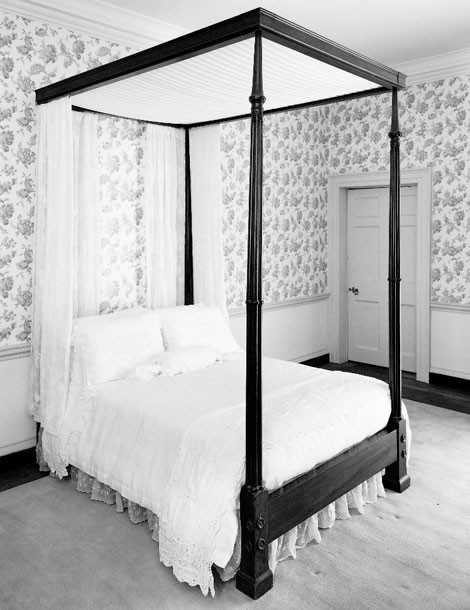
Bedstead with foot posts dating 1755–1770. The mahogany posts are probably British, although similar examples were made in Philadelphia. The bed that the posts came from probably had a carved or molded cornice and elaborate curtains.
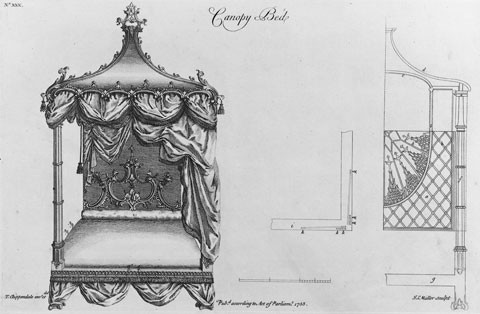
Design for a “Canopy Bed” with gothic posts illustrated on plate 30 in the first edition of Thomas Chippendale’s The Gentleman and Cabinet-Maker’s Director (1754). (Courtesy, Winterthur Library: Printed Book and Periodical Collection.)
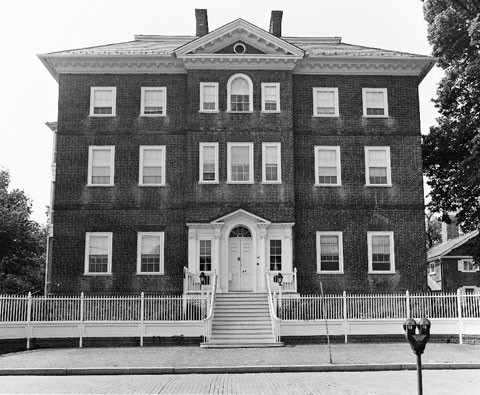
Chase-Lloyd House, Annapolis, Maryland, ca. 1773. Architect William Buckland was responsible for the interior and exterior design. He had previously worked on Mt. Airy, the home of Elizabeth Tayloe’s parents in Richmond County, Virginia.
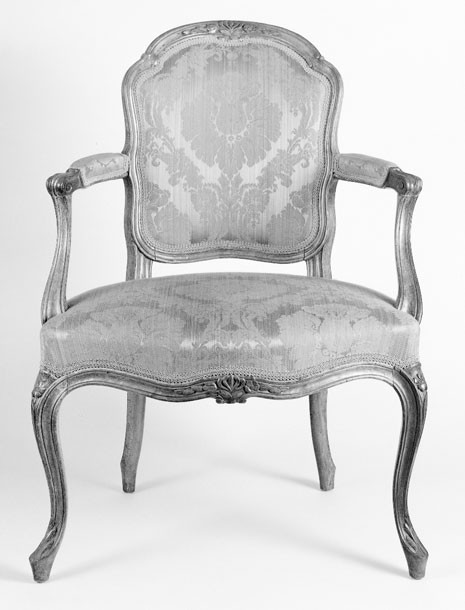
“French chair,” London, ca. 1772. Beech with oak. H. 34 1/2", W. (seat) 24", D. 20" (seat). (Photo, Gavin Ashworth.)

Bureau bookcase, London, 1750– 1760. Mahogany with cedrella, oak, and an unidentified conifer. H. 101", W. 47", D. 24". (Photo, Gavin Ashworth.) The gilding is modern.
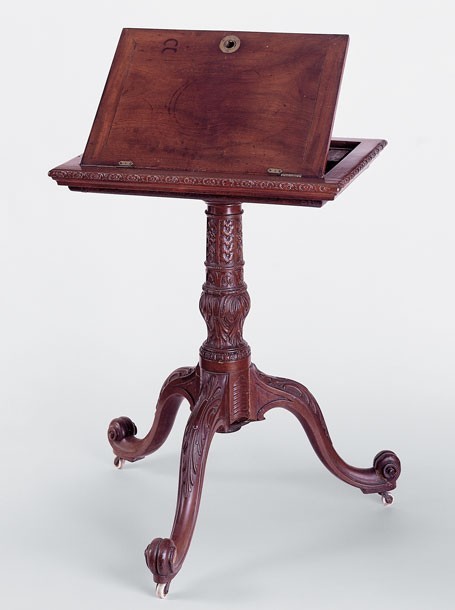
Bookstand, London, 1750–1760. Mahogany. H. 29", W. 24", D. 19". (Photo, Gavin Ashworth.)
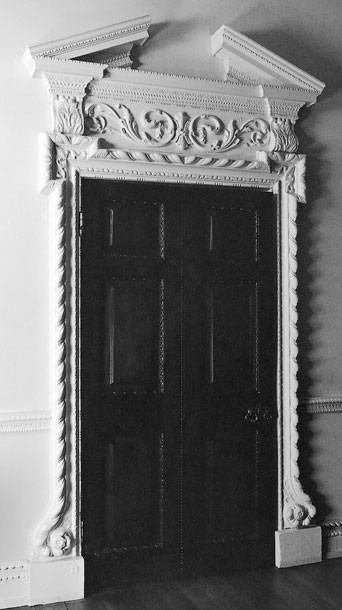
Detail showing one of the doors in the principal first floor room of the Chase-Lloyd House. The carving is attributed to Thomas Hall.
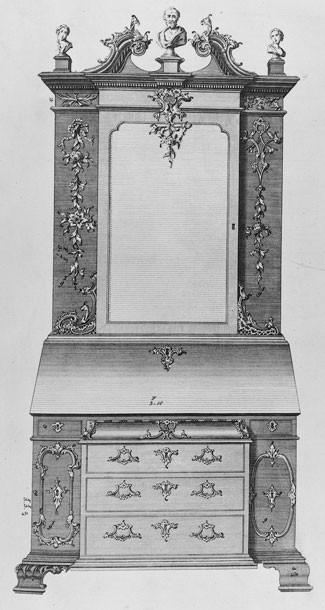
Design for a “Desk and Bookcase” illustrated on plate 78 in the first edition of Thomas Chippendale’s The Gentleman and Cabinet-Maker’s Director (1754). (Courtesy, Winterthur Museum Library: Printed Book and Periodical Collection.) This plate also illustrates leaves bound with ribbon as an optional frieze ornament on the left side. This motif, which occurs on the pier glasses ordered by Edward Lloyd III, was extremely popular in British furniture and architectural carving.
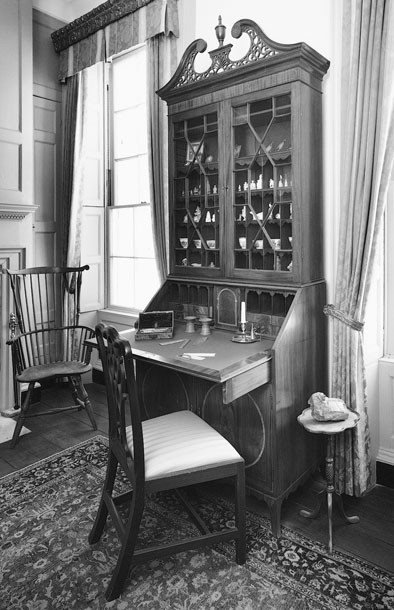
Desk-and-bookcase, Annapolis, John Shaw (active 1771–1819), 1797. Mahogany and light wood inlays with yellow pine and tulip poplar. H. 98 1/2", W. 41 1/4", D. 23 1/2". (Photo, Gavin Ashworth.) The design of the pediment is based on plate 57 of Thomas Sheraton’s The Cabinetmaker and Upholsterer’s Drawing Book (1793).

Detail of the pediment of the desk-and-bookcase illustrated in fig. 28. (Photo, Gavin Ashworth.)
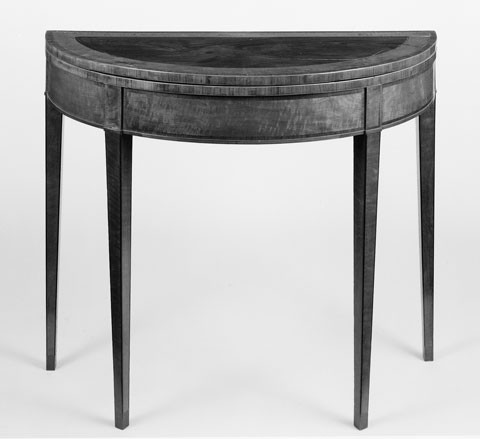
Card table, London, ca. 1772. Mahogany, satinwood and mahogany veneer, ebony and other unidentified inlays with beech and an unidentified soft wood. H. 29 1/2", W. 35 3/4", D. 16 3/4". This table is one of a pair remaining in Wye House. (Photo, Gavin Ashworth.)
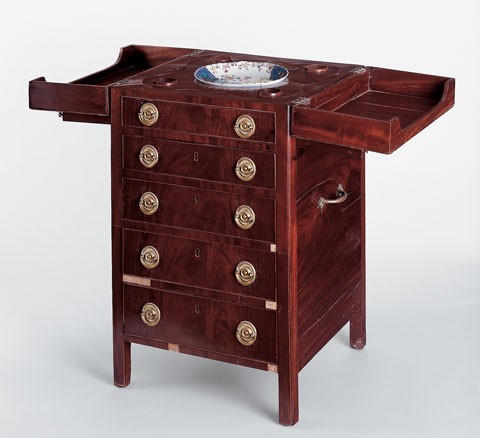
Shaving table, probably Annapolis, Maryland, ca. 1777. Mahogany with tulip poplar and yellow pine. H. 29 1/4", W. 19 3/4", D. 19 3/4". (Photo, Gavin Ashworth.)

Writing table, probably Annapolis, Maryland, ca. 1773. Mahogany with tulip poplar and yellow pine. H. 33", W. 36", D. 17 1/2". (Photo, Gavin Ashworth.)

Desk, Eastern Shore or Annapolis vicinity of Maryland, 1765–1780. Walnut with yellow pine. H. 38", W. 35 1/2", D. 18 1/2". (Photo, Gavin Ashworth.)

Side chair, England, ca. 1792. Mahogany with beech. H. 35 1/2", W. 21", D. 19". (Photo, Gavin Ashworth.) During the late eighteenth and early nineteenth centuries, Baltimore chair makers produced their own version of this splat design. Imported chairs like those ordered by Edward Lloyd IV probably influenced local production.

Side chair by Potthast Bros., Baltimore, Maryland, ca. 1917. Mahogany. H. 40", W. 24", D. 19". (Photo, Gavin Ashworth.)
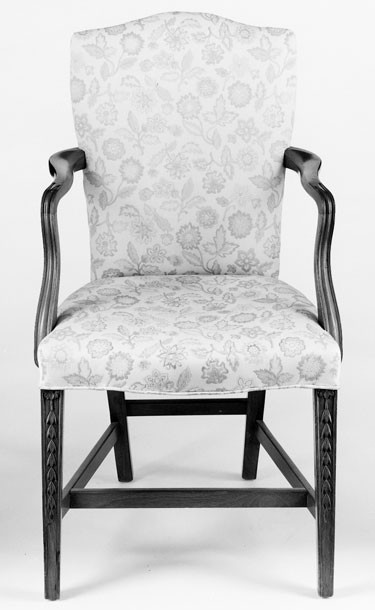
Armchair, England, ca. 1795, modified by J. W. Berry & Sons of Baltimore, Maryland, ca. 1920. Mahogany. H. 37 1/2", W. 22", D. 20". (Photo, Gavin Ashworth.)

Silver and glass plateau by William Pitts and Joseph Preedy with alabaster figures, London, 1792–1793. (Photo, Gavin Ashworth.) The three sections shown here are 52" long. With the two missing sections in place, the plateau measures 89 1/2".

Chest of drawers, England, ca. 1790. Mahogany and light wood inlay with oak and an unidentified soft wood. H. 35", W. 37", D. 22". (Photo, Gavin Ashworth.)
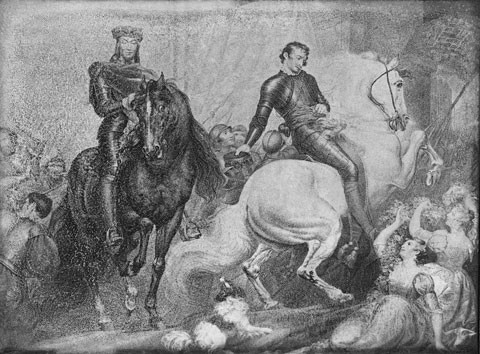
John and Josiah Boydell, Richard III Act V Scene II, London ca. 1792. Etching and engraving on wove paper. Frame dimensions: 22 1/2" x 30 1/2". (Photo, Gavin Ashworth.)
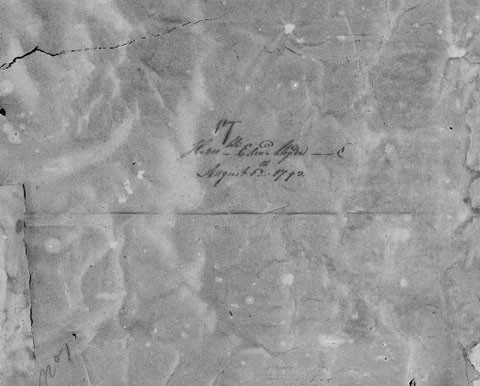
Detail of the back of the print illustrated in fig. 39. The inscription indicates that the print was part of a shipment to Edward Lloyd IV.
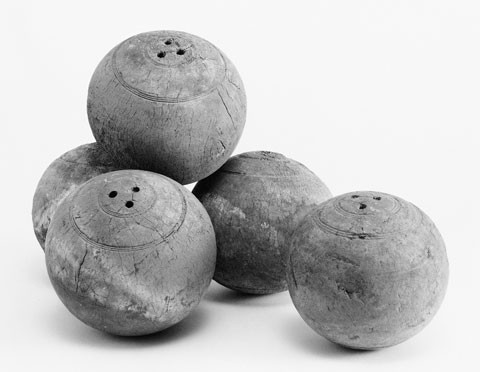
Balls for lawn bowling, England, 1785–1800. (Photo, Gavin Ashworth.)
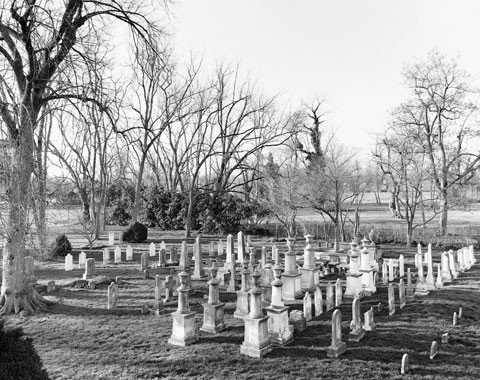
View of the graveyard at Wye. (Photo, Gavin Ashworth.)

View of the graveyard at Wye. (Photo, Gavin Ashworth.)
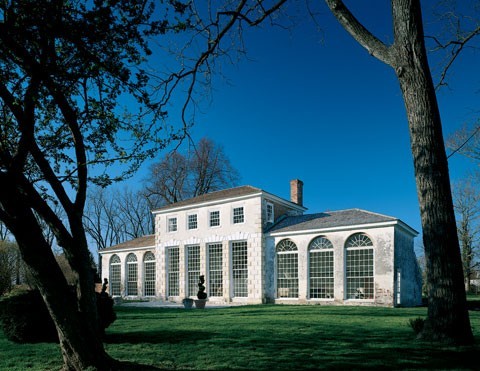
Greenhouse at Wye, Talbot County, Maryland, 1740s and 1786. (Photo, Gavin Ashworth.)
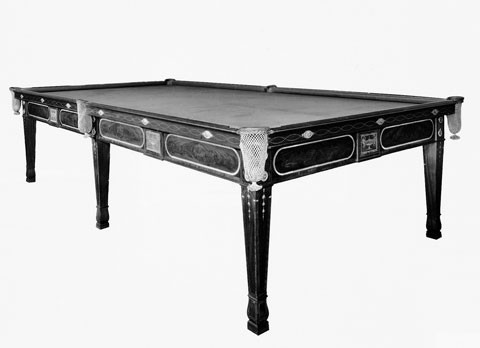
Billiard table by John Shaw, Annapolis, Maryland, ca. 1800. Mahogany and light and dark inlays with tulip poplar and yellow pine. H. 38", L. 139 1/2", W. 72 3/4". (Courtesy, Winterthur Museum.)
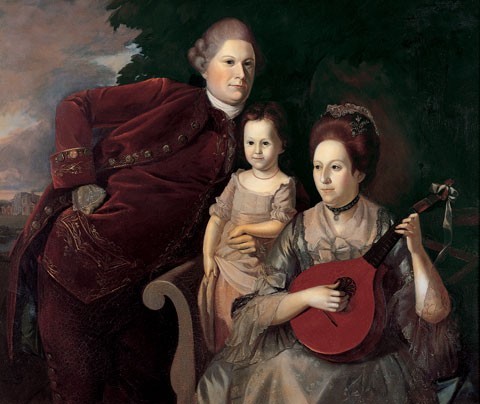
Jonathan Fairbanks after Charles Willson Peale, The Edward Lloyd Family, 1959. Oil on canvas. 43 3/4" x 52". (Photo, Gavin Ashworth.)
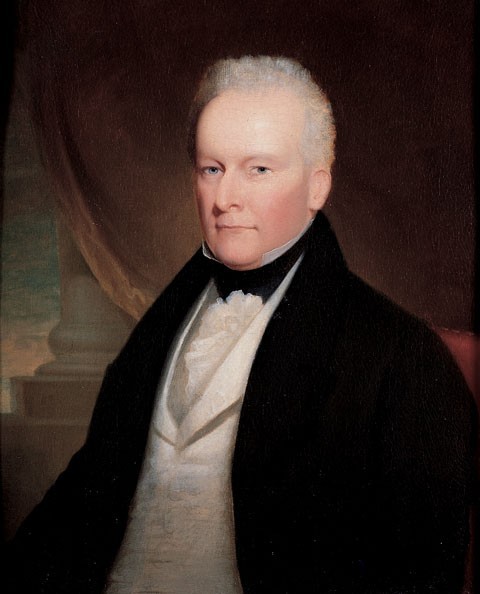
John Beale Bordley (1800–1882), Governor Edward Lloyd V, Maryland, 1828. Oil on canvas. 28 3/4" x 23 3/4". (Photo, Gavin Ashworth.)
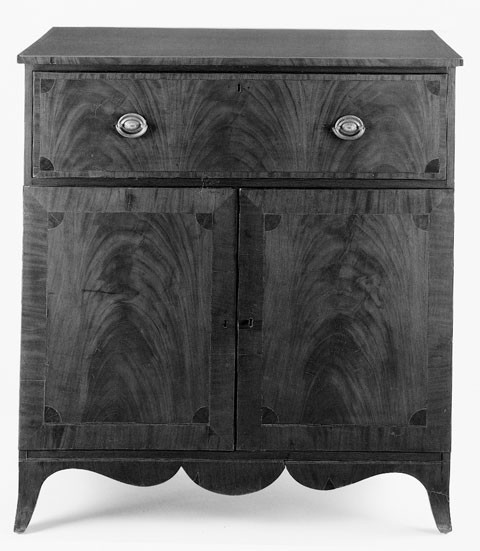
Secretary, Baltimore, Maryland, 1790–1800. Mahogany and light and dark wood inlays with yellow pine, tulip poplar, and white pine. H. 43", W. 42", D. 22". (Photo, Gavin Ashworth.)
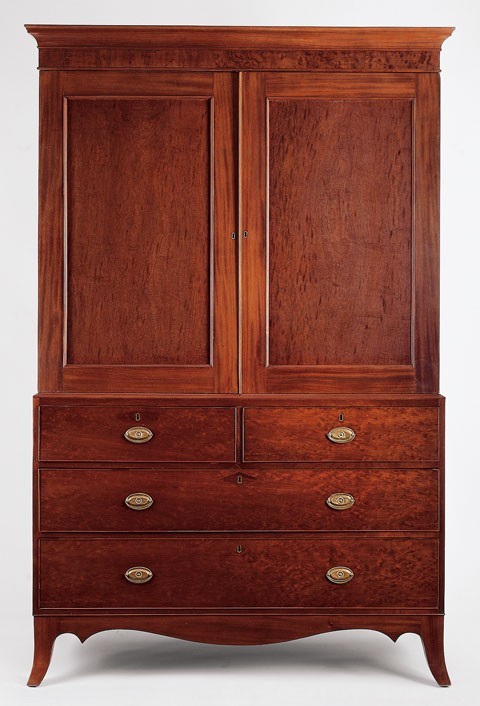
Clothes press, probably by James Martin, Baltimore, Maryland, 1797. Mahogany with tulip poplar and white pine. H. 82 1//2", W. 53 3/4", D. 24". (Photo, Gavin Ashworth.)

Card table, Baltimore, Maryland, 1790–1800. Mahogany and light and dark wood inlays with white pine, oak, and yellow pine. H. 31 1/2", W. 42 1/2" D. 21" (closed). (Photo, Gavin Ashworth.)
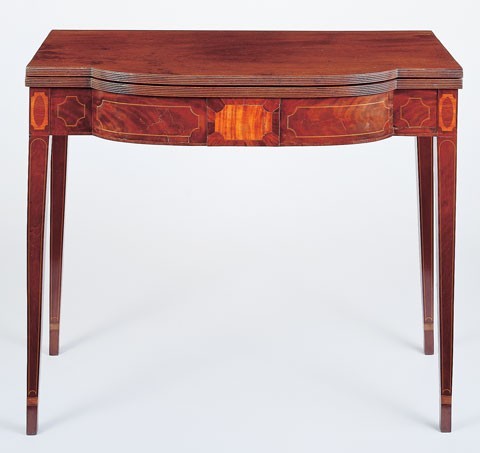
Card table, Baltimore Maryland, 1790–1800. Mahogany and light and dark wood inlays with white pine, oak, and tulip poplar. H. 29 1/2", W. 36", D. 18" (closed). (Photo, Gavin Ashworth.) One of the inlay woods is Botany Bay oak, an exotic from Australia.
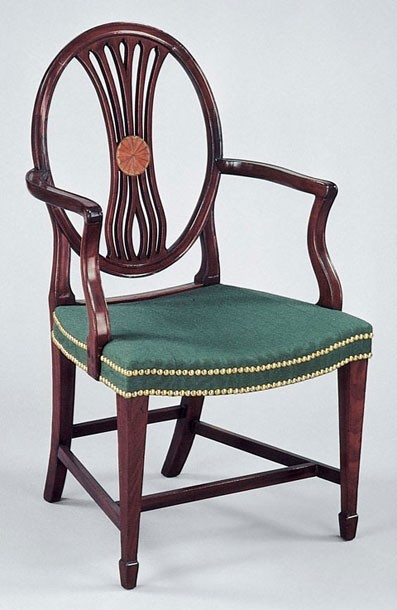
Armchair attributed to William Singleton (active 1790–1803), Baltimore, Maryland, ca. 1800. Mahogany and light wood inlays with tulip poplar, ash, and maple. H. 38", W. 21", D. 19". (Courtesy, Colonial Williamsburg Foundation.)
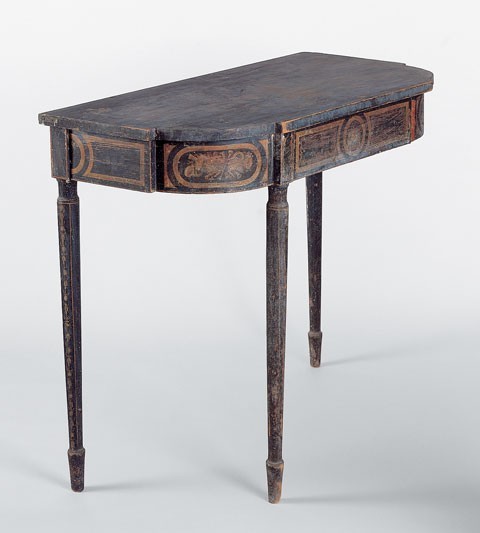
Card table with decoration attributed to John and Hugh Finley, Baltimore, Maryland, 1808–1815. Tulip poplar with oak, white pine, and maple. H. 28 3/4", W. 36", D. 18". (Photo, Gavin Ashworth.)

Cornice by John and Hugh Finley, Baltimore, Maryland, 1828. Tulip poplar. H. 8", L. 59". (Photo, Gavin Ashworth.) The festoon is missing.
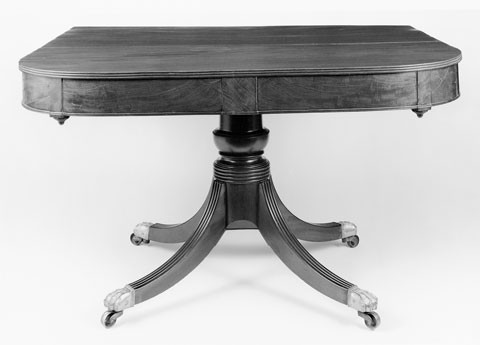
End of a three-part dining table attributed to Edward Priestley (active 1801–1837), Baltimore, Maryland, ca. 1812. Mahogany with tulip poplar and oak. H. 28 1/2", W. 56 3/4", L. 164" (with all sections assembled). (Photo, Gavin Ashworth.)
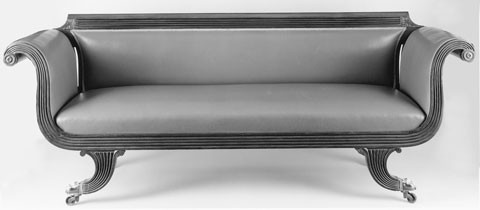
Sofa attributed to Edward Priestley, Baltimore, Maryland, ca. 1812. Mahogany with tulip poplar. H. 35", W. 96", D. 24 1/4". (Photo, Gavin Ashworth.)
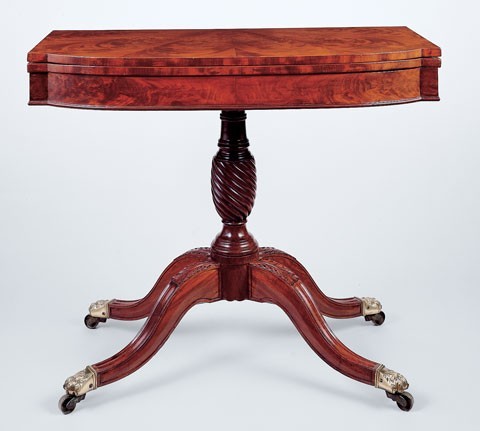
Card table attributed to Edward Priestley, Baltimore, Maryland, ca. 1812. Mahogany with white pine, tulip poplar, oak, and beech. H. 28 3/4", W. 36", D. 17 1/2". (Photo, Gavin Ashworth.)
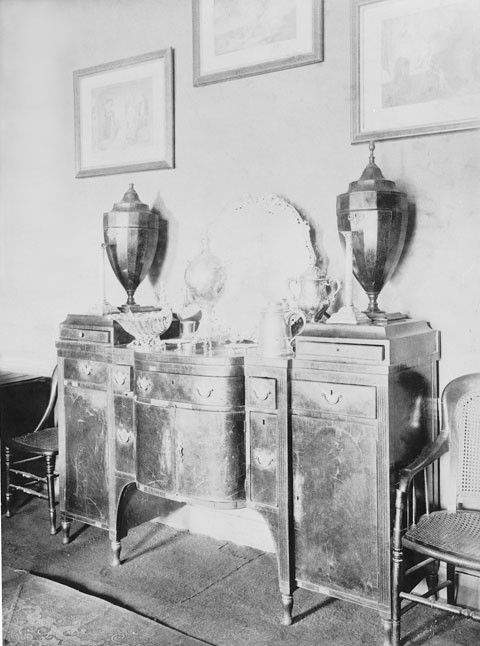
Circa 1915 photograph showing a sideboard attributed to Edward Priestley, Baltimore, Maryland, 1810–1815. (Photo, Gavin Ashworth.)
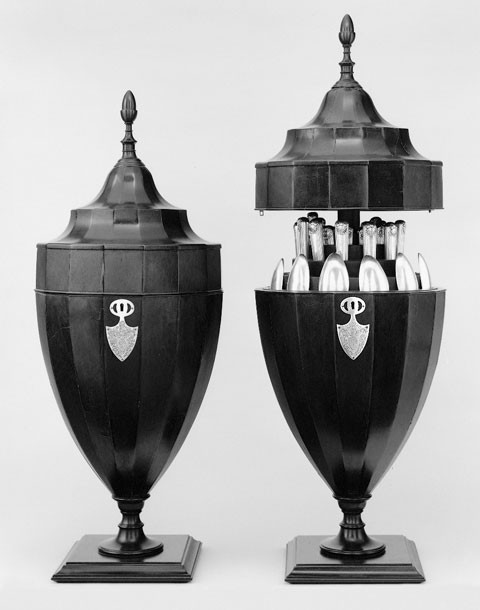
Pair of knife vases, England, ca. 1800. Mahogany with oak and an unidentified conifer. H. 29", Diam. 12 1/2". (Photo, Gavin Ashworth.)

Writing table attributed to Edward Priestley, Baltimore, Maryland, 1810–1815. Mahogany with tulip poplar and white pine; blue baize writing surface. H. 36", W. 36", D. 17 3/4". (Photo, Gavin Ashworth.)
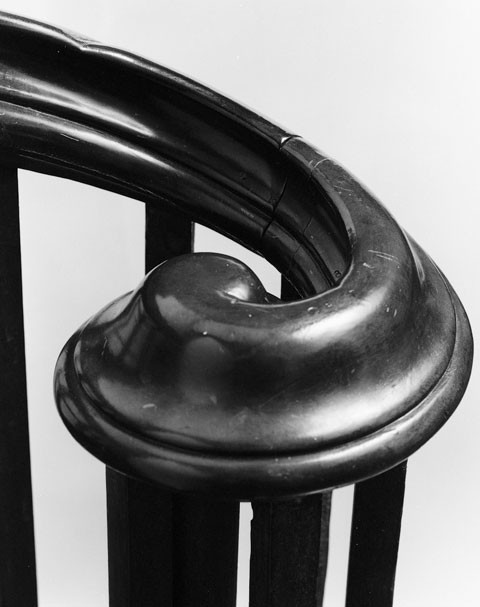
Section of handrailing by Edward Priestley, Baltimore, Maryland, 1826. Mahogany. (Photo, Gavin Ashworth.)
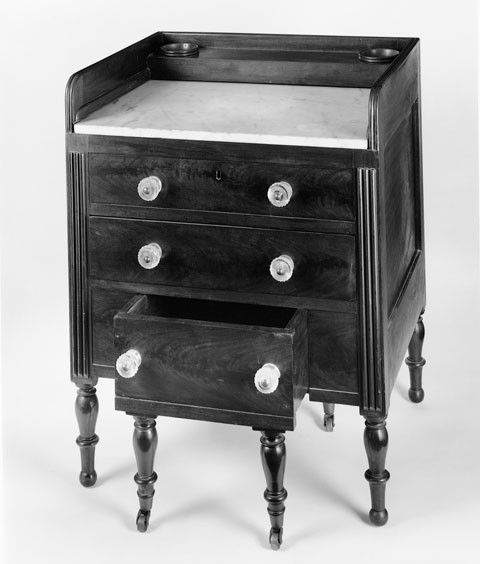
Chamber table, Baltimore, Maryland, ca. 1825. Mahogany with cedrella, white pine, and tulip poplar. H. 33", W. 26", D. 22". (Photo, Gavin Ashworth.)
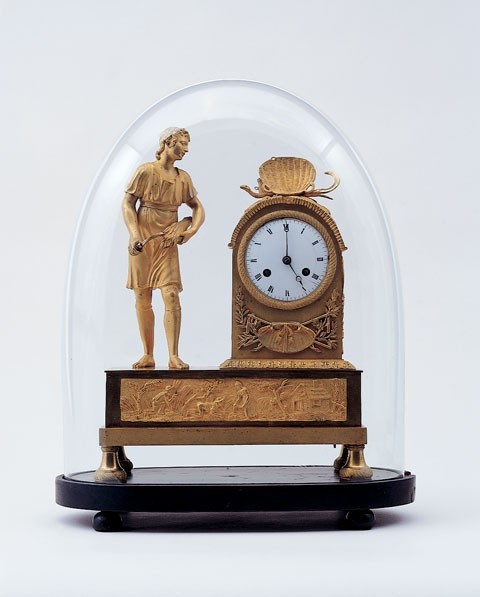
Mantle clock, France, 1810–1820. Bronze, brass, steel, glass, enamel, and silk. H. 14 1/2", W. 11", D. 4 3/4". (Photo, Gavin Ashworth.)
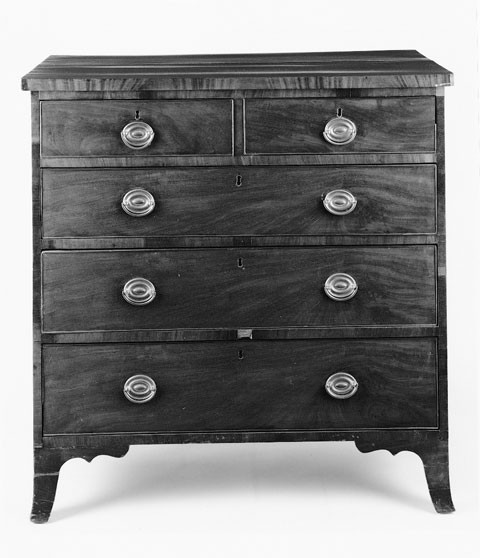
Chest of drawers, Baltimore, Maryland, 1795–1810. Mahogany with tulip poplar and white pine. H. 39 1/4", W. 39 1/2", D. 21 1/4". (Photo, Gavin Ashworth.) This chest is one of four that remain in Wye House.

Sideboard table and liquor case by Edward Priestley, Baltimore, Maryland, 1827. Sideboard table: Mahogany with tulip poplar and white pine; Pennsylvania clouded limestone. H. 42 3/4", W. 62", D. 26 3/4". Liquor case: Mahogany with tulip poplar and white pine. H. 20 1/4", W. 26 1/2", D. 17 1/2". (Photo, Gavin Ashworth.) Carved heads like those on the table are illustrated on plate 57 of Thomas Hope’s Household Furniture and Interior Decoration (1807).
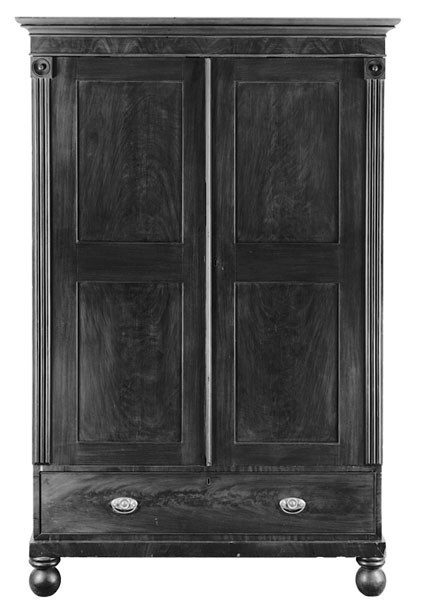
Wardrobe, Baltimore, Maryland, 1825–1835. Mahogany with white pine and tulip poplar. H. 82", W. 54", D. 23 1/2". (Photo, Gavin Ashworth.)
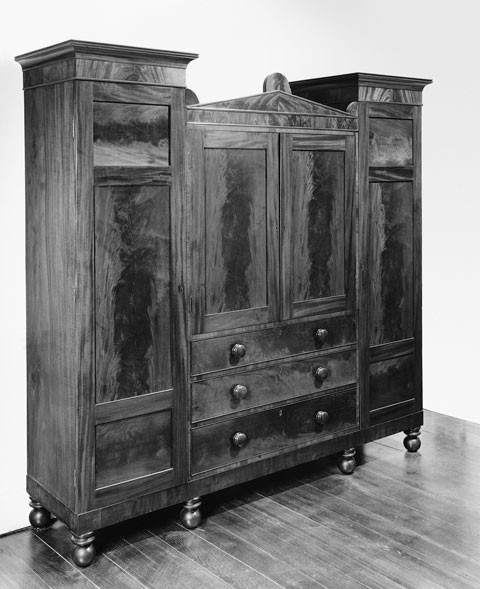
Wardrobe, Baltimore, Maryland, ca. 1825. Mahogany with white pine and tulip poplar. H. 80", W. 80", D. 20". (Photo, Gavin Ashworth.)
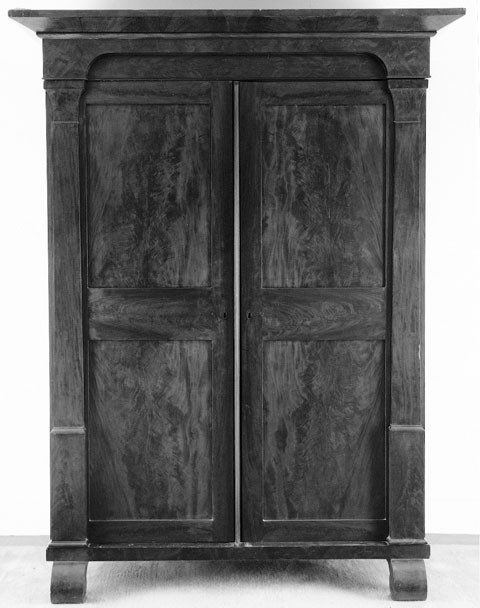
Wardrobe, Baltimore, Maryland, 1835–1845. Mahogany and rosewood inlay with white pine and tulip poplar. H. 86 3/4", W. 57", D. 21 1/2". (Photo, Gavin Ashworth.)
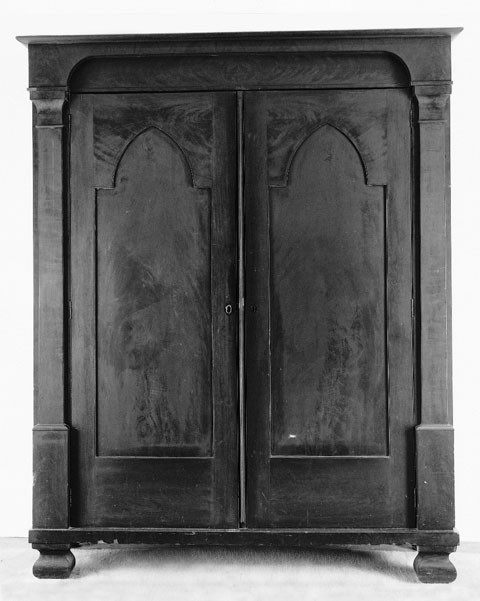
Wardrobe, Baltimore, Maryland, 1835–1845. Mahogany with white pine, tulip poplar, and white cedar. H. 84 1/2", W. 66 1/4", D. 21". (Photo, Gavin Ashworth.)
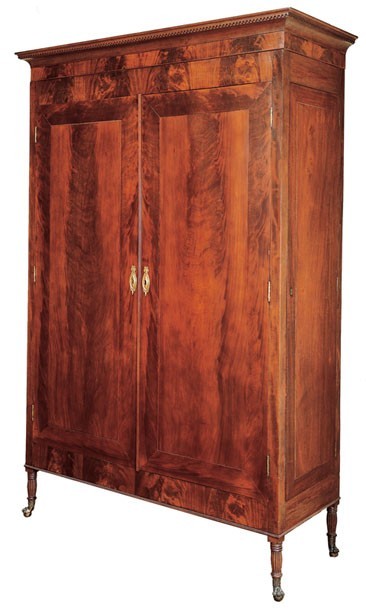
Armoire, probably New Orleans, Louisiana, ca. 1825. Mahogany with cypress, tulip poplar, and white pine. H. 90 1/2", W. 56 1/2", D. 21 3/4". (Photo, Gavin Ashworth.)

Side chair, possibly by Tweed & Bonnell, New York, 1835–1840. Mahogany. H. 34", W. 18 1/2", D. 18 1/2". (Photo, Gavin Ashworth.)

Sideboard table, Baltimore, Maryland, 1825–1835. Mahogany with tulip poplar, oak, and white pine; marble. H. 40", W. 56", D. 24 3/4". (Photo, Gavin Ashworth.)
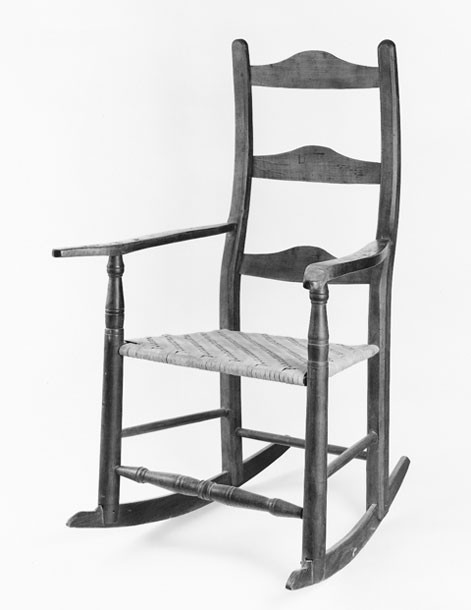
Rocking chair, probably Talbot County, Maryland, 1830–1840. Maple with oak. H. 46", W. 28 1/2", D. 33". (Photo, Gavin Ashworth.)

View of the north side of Wye House. (Photo, Gavin Ashworth.)
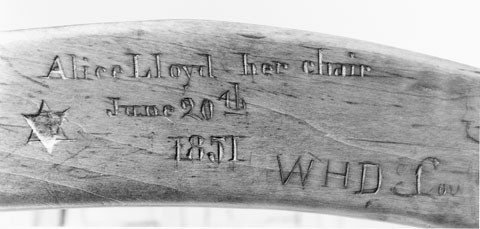
Detail of the left arm of the rocking chair illustrated in fig. 73.
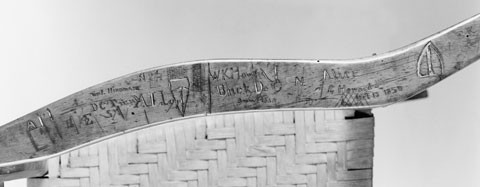
Detail of the right arm of the rocking chair illustrated in fig. 73.
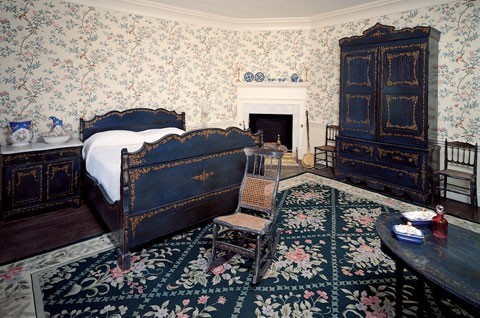
Bedroom suite, Hart, Ware & Co., probably Baltimore, ca. 1855. (Photo, Gavin Ashworth.) Hart, Ware & Co. maintained warehouses in Philadelphia from 1852 to 1854 and in Baltimore from 1855 to 1859. The suite has painted decoration in imitation of mother-of-pearl.
Objects are what matter. Only they carry the evidence that throughout the centuries something really happened among human beings.
—Claude Levi-Strauss
The survival of objects can be the result of either random or purposeful acts, whereas collections are by definition intentional. Most institutions have mandates and policies governing acquisitions, but their collections invariably reflect the interests and goals of successive curators, administrators, and donors. In contrast, private collections generally embody the tastes, interests, and aspirations of one or two individuals. Groups of objects acquired and preserved by consecutive generations of a single family are often described as “collections,” but they are actually assemblages because each generation reassesses and reorders objects and ephemera based on their own views regarding aesthetics, personal and family identity, historical significance, and sentiment. By revealing what specific consumers and their progeny deemed important and valuable, family assemblages often represent a more direct and more informative link with the past than do institutional and private collections.[1]
The furniture and furnishings of the Edward Lloyd family of Wye House (fig. 1) in Talbot County, Maryland, provide a unique opportunity to consider possessions that descended in an important American family. These objects raise several intriguing questions: Where, how, and why did their original owners acquire them? In what context were these objects used, and what do they say about the Lloyds’ wealth, tastes, social status, and self-perception? Why do these objects survive?
The history of the Lloyd family of Maryland began in 1659, when Edward Lloyd I (ca. 1610–1696) acquired 3,500 acres of land in Talbot County with the intention of establishing a tobacco farm. He named the property and the river adjacent to it Wye, after the Wye River in his native Wales. Edward I and his descendants accumulated power and money through political positions, the establishment of lucrative trade routes, and politically and socially advantageous marriages. By the 1770s, the Lloyds were one of the wealthiest and most powerful families in America.[2]
Built in 1787 by the fifth proprietor, Edward Lloyd IV (1744–1796), the present Wye House is presumably the fourth house built on the property. The previous ones fell victim to their proprietor’s desire to build a newer and more current residence. Just as Edward IV’s Wye house is the only dwelling surviving on the estate, the furniture that remains there is merely a fractional representation of what each proprietary family owned. For at least four generations (1718–1834), elder sons rose to power in the wake of their father’s death. They dispersed possessions to siblings, purged vast quantities of household goods, and bought anew. Successive generations used the cultural criterion of their own time to decide what to save and what not to save from the patrimony of previous generations. Throughout this period, the old furnishings preserved by the Lloyds and the new objects acquired by each patriarch served as vehicles for conveying power and social status and defining respective proprietorships.
Financial reversals contributed to the survival of some furnishings and the loss of others. By the 1850s, income from agricultural products grown at Wye had declined, reducing the family’s ability to maintain the house and outbuildings and acquire new furnishings and interior decorations. Although the Lloyds were less active consumers during the mid-nineteenth century, they remained intensely interested in their family’s legacy. These sentiments continued long after the Centennial, propelled by the colonial revival and the Lloyds’ awareness of their place in local and national history.
By the first decade of the twentieth century, debts at Wye were mounting, and many buildings on the property were in dire need of repair. The Lloyds had sold thousands of acres of land since the Civil War, but the proceeds were quickly exhausted. In 1906, Wye ceased to pass from father to eldest son when Edward Lloyd VIII (1857–1948), a commodore in the United States Navy, realized that he could not afford the taxes due upon the death of his father Edward VII (1825–1907). To maintain family control of the estate, Mary Donnell Lloyd (1865–1943)—the wife of Edward VIII’s younger brother Charles Howard Lloyd (1859–1929) (fig. 2)—purchased Wye House, its outbuildings and contents, and several thousand acres of land from Edward VII for $2,726.80 with money she had inherited from her family. Charles and Mary lived in Baltimore, residing at Wye House only seasonally. In 1943, their daughters Joanna Leigh Lloyd Singer (1895– 1972) and Elizabeth Key Lloyd Schiller (1897–1993) inherited the property, and Elizabeth and her husband Morgan B. Schiller moved there. Joanna’s daughter, Mary Donnell Tilghman (neé Singer) (b. 1919), inherited Wye in the 1990s and has used the latest and most careful methods of conservation to preserve the house, its outbuildings, and its furnishings.[3]
Although early proprietors routinely sold household goods through auctions and direct transactions, Charles Howard Lloyd, his wife Mary, and their daughter Elizabeth Lloyd Schiller were the most aggressive. Their efforts to preserve and restore Wye House were strongly influenced by colonial revival attitudes, which tended to romanticize the past. Charles, Mary, and Elizabeth made significant strides in improving the appearance of Wye House and oversaw the division of objects to Charles’ seven siblings after Edward VII died and sold unwanted furnishings as well. To re-create a semblance of the house’s colonial grandeur, they kept only what they perceived to be “true antiques” and replaced objects not fitting this criteria with colonial revival reproductions made by the Potthast brothers in Baltimore. The fact that the furnishings surviving at Wye House endured so many generations of taste and perception makes them even more rare, more evocative, more iconic.[4]
A strong tradition of patriarchy and primogeniture allowed Wye to descend from father to eldest son into the twentieth century—when ownership passed to the second son, and then to his two daughters—and the property remains in the possession of the eleventh generation today. Because furniture and other decorative arts associated with the Lloyd family have not entered the public domain, they have not captured the attention of scholars to the same degree as those that descended in many less influential families. It was, after all, the Lloyd family’s wealth that purchased the lavish and well-documented furnishings of John (1742–1786) and Elizabeth (Lloyd) (1742–1776) Cadwalader.[5]
Edward Lloyd III
Edward Lloyd III (1711–1770) is often remembered today as the wealthy father-in-law of Philadelphia merchant John Cadwalader (1742–1786), but in the eighteenth century he was a prosperous planter and a stalwart member of the Maryland General Assembly and Governor’s Council who supported Tory politics with diehard fortitude. Edward III’s death in January 1770 spared his family from the political, financial, and social demise that befell other Maryland loyalists after the revolution. His will, written eighteen years earlier, left half of his considerable estate to his eldest son Edward IV (1744–1796) (fig. 3) and divided the remaining half equally beween his youngest son Richard Bennett (1750–1787) (fig. 4) and his daughter Elizabeth or her husband (fig. 5). This document conflicted with Edward III’s verbal, bedside instructions that his estate be divided in equal thirds. The discrepancy between the written and oral mandates ignited a major quarrel, which played itself out in heated correspondence between Edward IV and John Cadwalader, who represented Elizabeth’s and Richard’s interests as well as his own. By early 1771, Edward IV succumbed to his angry siblings and agreed to divide the estate equally between the three heirs. The only documents pertaining to the house and furnishings of Edward III are two inventories, though neither may be complete. His probate inventory lists objects room by room and notes their values, and a private inventory designated who inherited what by the initials “JC” (John Cadwalader), “EL” (Edward Lloyd IV), and “RL” (Richard Bennett Lloyd).[6]
Both of Edward III’s inventories begin by listing his lavish silver equipage, all procured through London agents and lending a palpable reminder of the Lloyds’ London-based wealth. The rooms are designated by function, color, and location, except for the bedrooms, which are identified by the names of family members who traditionally slept there. It is clear that furniture had been shuffled and removed by the heirs since the parlor contained no chairs and the dining room contained no table.[7]
John Cadwalader received most of the furnishings in the large bedroom over the passage, designated “The Colonel’s” (Edward III’s). This room contained a high-post mahogany bedstead with blue silk furniture, matching window curtains, a bottle stand and basin, two Wilton bedside carpets, prints, a settee bed, a dressing table with a cover and corresponding glass, and a pair of andirons with shovel and tongs. The only object that Edward IV received from his father’s bedroom was a close stool easy chair valued at £4.8.[8]
Richard Lloyd inherited the contents of the small passage, two bedrooms, and the dressing room over the dining room. The passage furnishings included two settees with covers, a large round table, a tea table, a breakfast table “eight square,” two floor mats (one large and one small), a large old map, and thirteen paintings. A small mahogany bedstead with furniture, two dressing tables with glasses, a japanned tea table, six chairs, a bottle stand, and two pairs of andirons with shovels and tongs were in the bedroom over the parlor and the dressing room over the dining room. The other bedroom, formerly occupied by Richard’s mother Anne Rousby Lloyd (1721–1769), had a variety of expensive furnishings: a mahogany bedstead with yellow silk furniture, two matching window curtains, six chairs with yellow silk damask “bottoms,” two armchairs, a chimney glass, a japanned cupboard, two brackets with porcelain pots painted with flowers, a print of John Wilkes, a mahogany stand, and a fire screen. Richard subsequently sold the settees with covers from the passage and the side chairs and one armchair from his mother’s bedroom to Edward IV.[9]
An English walnut armchair (fig. 6) in Wye House may be the latter seating form. It appears to date about 1760, which is too early to have been commissioned by any of Edward III’s children. Edward Lloyd III’s inventory lists an armchair valued at £10, an amount sufficient for an example with an upholstered back, seat, and arms. This armchair may also be the “large” one valued at £2.5 in the 1796 inventory of Edward IV. Referred to as “cabriole,” “French,” or “elbow” chairs in English design books, such armchairs were considered appropriate for both parlors and bedrooms.[10]
With the exception of the silk window curtains, which went to Edward IV, all of the parlor furnishings passed to the Cadwaladers. The couple received a large looking glass, a chimney glass and two sconces, a marble slab (presumably with a wooden frame), an old carpet, and a pair of andirons with shovel and tongs. Edward IV inherited the contents of the dining room and “Great Passage.” The dining room furnishings included two large gilt pier glasses, two silk damask window curtains, twelve chairs with silk bottoms and covers, four paintings, two fire screens, a tea table, a japanned tea table, a card table, four flower pots on brackets, and a pair of andirons with shovel and tongs; and the passage had a large and a small painted and gilt screen and eight flag bottom chairs.[11]
Random furniture not considered as part of a suite or for a specific room appears separately in the inventories. Cadwalader received ten mahogany side chairs and two mahogany armchairs with carpet bottoms, a Wilton carpet, and a shagreen case with silver handled knives and forks. Richard Bennett Lloyd inherited six chairs with damask bottoms, a broken mahogany card table, a broken tea table, a broken round table, mattresses, and a Wilton carpet. Edward IV received a sideboard table, a sideboard, a bureau, two leather armchairs, eight chairs with yellow damask bottoms, two fire screens, two sets of silk window curtains, an old clock, a Wilton carpet, and a shagreen case with silver mounts and five bottles. The three heirs divided twenty “common” and “low mahogany” beds and mattresses.[12]
A tall clock case at Wye House (fig. 7) has an eight-day movement by English clockmakers Daniel Quare and Stephen Horseman, who were in partnership from 1709 to 1720. This movement probably came from the “old clock” inherited by Edward IV, who replaced the original case with a more up to date, locally made one. The date range attributable to the movement suggests that the original owner was Edward II (1670–1718). Family photographs indicate that the clock has been secured to the passage wall since at least the late nineteenth century.[13]
The proceeds from two auctions recorded in Edward III’s estate ledger reveal that his heirs sold unwanted household furnishings. Each heir received £478.8.11 from a sale held in Philadelphia on September 6, 1770, and Edward IV and Richard received £113.9.2 from a sale of their unwanted goods held in Annapolis a year later. The Annapolis auction included textiles, kitchen utensils, chinaware, foodstuffs, and furniture, although only “a looking glass” was specified. Buyers from various social and economic strata vied for these goods. Among the successful bidders were royal governor Robert Eden (1728–1804), architect William Buckland (1734–1774), silversmith William Farris, ship captain, merchant and cabinetmaker Joseph Middleton, cabinetmaker Archibald Chisholm (d. 1810), cabinetmaker William Tuck, the Lloyds’ agent Arthur Bryan, merchant Richard McCubbin, and Thomas, “the servant man at the Middleton’s.”[14]
Many of the furnishings retained by the heirs document Edward III’s patronage of London tradesmen and his and his progeny’s familiarity with mid-eighteenth-century, European court styles. Silver served as one of the most potent symbols of the Lloyds’ wealth, social status, and taste. Much of the equipage listed in Edward III’s inventory was given to later generations of Lloyds, most often as wedding gifts. Of the silver that survives, two pieces are remarkable for their ownership and survival in an American context. The large tea waiter, or salver, valued at £242 features a cast rim with decorative allusions to the Lloyds’ wheat farming and an elaborately engraved “shield” with the arms of Lloyd impaling Rousby (figs. 8, 9). London silversmith Jacob Marsh made the waiter in 1754, but the name of the engraver is not known. The appraiser’s assessment of this monumental waiter was more than twice what Philadelphia cabinetmaker Thomas Affleck charged John Cadwalader for making eighteen major pieces of furniture, two window cornices, and two knife trays, and performing sundry repairs and services between October 13, 1770, and January 14, 1771. Maryland and Pennsylvania currency had almost equal value during the early 1770s. Besides effectively conveying the Lloyd family’s wealth, the waiter is steeped in lore. Family tradition maintains that during the late eighteenth and early nineteenth centuries newborn Lloyd children were placed on the salver and presented to their father.[15]
Edward III’s inventory also notes that Richard Bennett Lloyd sold Edward IV a bread basket for £88. Made by John Wirgman in 1754, this imposing object (fig. 10) also has trophies pertaining to wheat farming. The reticulated nautilus shape alludes to fertile ground—the source of Edward III’s immense wealth—and the handle depicts the goddess of the harvest, Demeter (Greek) or Ceres (Roman), holding a shield engraved with the Lloyd coat of arms. John Cadwalader and Richard Bennett Lloyd divided a set of four large candelabra, each of which held twelve candles and had sixteen “savealls.” None of these objects are known to have survived, nor did they appear on any of the inventories of Edward III’s heirs. Given the fact that they were valued £118 each, the candelabra must have rivaled the magnificence of Edward III’s surviving silver.[16]
Numerous English, French, and Chinese porcelain dining services complemented Edward III’s silver, but only the tobacco leaf set remains at Wye (fig. 11). Comprised of several hundred pieces, this service was described as “Ribbd,” “Enameld,” and “Enameld china” in his inventory. Edward IV inherited one-third of the tobacco leaf porcelain and purchased the remaining two-thirds from Cadwalader and Richard Bennett Lloyd. No other porcelain, either useful or ornamental, survives from the elder Lloyd’s proprietorship.[17]
Unlike most of his peers, Edward III controlled every facet of his business—thousands of acres of land, hundreds of slaves, several mills and drying houses, and a fleet of schooners that transported wheat and tobacco from Maryland to London. The family’s connection to the water and involvement in transatlantic commerce may have prompted Edward III’s heirs and their progeny to preserve a pair of deck cannons (fig. 12) from his private schooner. Edward III used the cannon to “thunderously report” his arrival in port as did Edward IV, V, and VI, the latter having transferred the two pieces of artillery to their own private schooners. According to family tradition, the cannons were last discharged in 1865 when Admiral Franklin Buchanan (1800–1878), who was married to Edward V’s daughter Anne Catherine Lloyd (1808–1892), repelled Union deserters attempting to burglarize Wye House.[18]
The dispersal of Edward III’s estate and redecorating by generations of his extended family has left only a small amount of furniture that can be associated with his proprietorship. At present, it is unclear where the furniture inherited by Richard Bennett Lloyd and the Cadwaladers ended up. It is possible that John and Elizabeth decorated their Kent County, Maryland, estate—Shrewsbury Farm—with some of her father’s furnishings. At the very least, Edward III and Anne’s interiors inspired those that the Cadwaladers created in the Philadelphia townhouse Edward III urged them to purchase. The silk curtains and upholstery fabrics in John and Elizabeth’s principal first floor rooms were yellow and blue like those in Wye House. Edward III and Anne’s color choices may have been inspired by the Lloyd family coat-of-arms, which is azure and gold (figs. 13, 14). These colors would also have resonated with John Cadwalader, whose crest features a gold cross formé fiché against an azure ground. The Cadwaladers also had the ten mahogany side chairs and two armchairs they inherited recovered by Philadelphia upholsterer Plunkett Fleeson, and they augmented the Wilton carpets from Wye House with others purchased through their London agent Mathias Gale. Although the side chairs and armchairs are not known to have survived, it is conceivable that they served as models for the well-known ribbon-back set that the Cadwaladers commissioned about 1769 (fig. 15).[19]
The Wye House of Edward Lloyd IV
After the revolution, Edward IV became less active in politics and moved from Annapolis to Wye in hopes that country life would remedy the gout that debilitated him. Like other enlightened men of his era, he studied art and architecture and amassed a large and useful library. Many of the architectural design books he acquired remain in his house today. In fact, entries in Edward IV’s ledgers suggest that he designed and supervised the construction of the surviving residence at Wye.[20]
In 1781, Edward IV instructed his overseer James Burke to move the contents remaining in his father’s house to Forrest Plantation, a neighboring Lloyd plantation. These items included a writing desk with papers, several mahogany chairs, a large mahogany couch with a check cover, a mahogany stand, two large gilt pier glasses, two “fincured” knife cases, window blinds, tea china, glass, chimney-piece ornaments, andirons, fender grates, shovels and tongs, bird cages, a drum and a pair of drum sticks, six guns and six barrels, and nine pieces of flagstone. The following year, Edward IV demolished his father’s residence and commissioned engineer Charles Gardiner to survey the site to establish a perfect north-south axis for his new Wye House (fig. 16). Entries in Edward IV’s ledgers from 1781 to 1788 document expenditures for building materials—wood for the framing and weather boarding and brick (some fired at Wye) for wall filler. On March 13, 1787, joiner William Eaton received £9.3.4 for “shifting the studs of the main house to prepare for weatherboarding.”[21]
Construction must have been nearing completion the following year. A docket from Edward IV’s Baltimore agent dated March 1788 lists furnishings and other goods shipped aboard the former’s schooner to Wye. Included were powder yellow, boiled oil, raw oil, whiting, turpentine, fat oil, vitriol, litharge of gold, twenty books of gold leaf, twelve paint brushes, and nine other paint tools, presumably for re-gilding the pier glasses moved from Forrest Plantation to Wye House. Formerly thought to date from the late eighteenth century, these remarkable glasses (figs. 17, 18) show how profoundly Edward III’s furnishings influenced the material world of his children.[22]
The large north parlor in Edward IV’s residence was designed specifically to accommodate the pier glasses, which are the same height, but differ in width (fig. 17). Although earlier scholars believed that these objects were neoclassical imports, documentary evidence and microscopy suggest that they are the two pier glasses Edward IV inherited from his father’s dining room and that the materials listed in the docket were for re-gilding them. Leaf and ribbon appliqués similar to those on the Lloyd examples are illustrated in architectural design books such as William Jones’ Builders Companion (1739) and occur on British looking glass frames from the second quarter of the eighteenth century. The guilloche borders of the pier glasses also have architectural parallels. Plate 78 of Batty and Thomas Langley’s The Builder’s Jewell (1741) shows a popular variant in the upper right corner (fig. 19).[23]
As centerpieces of the most prominent room in Wye House and unable to be closeted, the pier glasses survived the purges of Edward IV and seven consecutive generations of his family. From the late 1780s to the present, the Lloyds have referred to this room as the “parlor,” but Edward IV and his descendants also used it for large dinner parties. With the dining table placed on the north-south axis and the pier glasses reflecting the candlelight, the room undoubtedly made a dazzling impression. The glasses hung just above the chair rail with their tops canted forward until 1823 when Edward V installed a wider cornice and lowered them. The distance between the two sets of screw holes on each frame equals the amount that they were lowered and the amount they presently hang below the chair rail (see figs. 17, 18). Neither glass appears to have been moved since 1823.[24]
A third pier glass presumably obtained by Edward IV to complement the two he inherited from his father does not survive, but it is described in the younger Lloyd’s inventory as “a gilt frame looking glass...£15.” The value of this object and its listing adjacent to the “pair [of] large Gilt frame looking glasses...£100” suggests that all three were in the same room. Edward V’s account and subsequent dispute with the London mercantile firm Thomas Eden, Christopher Court & Company also confirms the use of a third looking glass in the north parlor. In 1810, the former ordered “three” pairs of cut crystal girandoles to stand in front of the parlor glasses (see fig. 17).[25]
Edward V may have displayed the girandoles on tables in front of the pier glasses. The 1861 inventory of his son Edward VI documents this practice, as do later photographs of the north parlor of Wye House. During the late nineteenth and early twentieth centuries, the D-shaped ends of a large classical dining table (see fig. 55) supported the girandoles while the other sections remained assembled for dining in the adjacent “withdrawing room.” Elizabeth Lloyd Schiller replaced the D-ends with elliptical table sections (see fig. 17) she rescued from a barn loft. These sections may comprise all or part of one of the seven dining tables belonging to Edward IV.
Since the proprietorship of Edward Lloyd III, the pier glasses have defined the most important room in Wye House. Given their presence and the fact that they dictated the placement of other furniture forms and lighting devices, it is remarkable that these fragile objects endured the refurnishing and redecorating of subsequent generations. For the Lloyd family, these pier glasses have always represented a tangible connection with the grandeur of their eighteenth-century past.
In the Wye Houses of Edward III and Edward IV, bedsteads also provided a framework for lavish displays of wealth, primarily in the form of imported textiles. Edward III and his wife Anne both had bedsteads with silk furniture that matched the window curtains in their respective bedrooms. Edward IV and Elizabeth had comparable fabrics. In 1780, they paid £720 for eighteen yards of pink silk ordered from France. In the early twentieth century, Charles and Mary Lloyd sold a large quantity of furniture including several bedsteads. Only one early bedstead (fig. 20) remains in Wye, having been rescued from a tenant house by Elizabeth Lloyd Schiller in 1950. Related to both British (fig. 21) and Philadelphia examples from the third quarter of the eighteenth century, it has gothic footposts and large Marlborough feet.[26]
Edward IV: Conspicuous Consumption
The inventories of Edward IV’s houses at Wye and Annapolis paint a picture of a man who proudly earned the appellation his descendants bestowed upon him—“Edward the Magnificent.” Excluding real estate, the value of his personal effects totaled £38,785.12.6, £11,000 of which were household furnishings (almost exactly ten percent of his entire wealth). Many of his possessions reflected personal interests, intellectual pursuits, and leisure activities. He had a library comprised of 2,500 volumes and owned a camera obscura, a mahogany compound microscope, surveying instruments, spy glasses, physics scales, a mahogany case of instruments for the recovery of drowning persons, several pairs of silver mounted pistols, 640 bottles of Madeira, 1822 bottles of sweet wine, sixty-nine pints of port wine, three demi-johns of apple brandy, a case of gin and brandy in cut glass bottles, and a cask of whiskey. He also maintained a park with sixty-one fallow deer and a small personal fleet consisting of barges, phaetons, and a schooner. The furniture in his residences included 103 side chairs, twenty-two armchairs, six settees, a sofa, nine Pembroke tables, seven card tables, six dining tables, five dressing tables, three writing tables, six washstands, three fire screens, eight bureaus, six desk-and-bookcases, six desks, one secretary bookcase, two bookcases, four clothes presses, and three sideboards. Although Edward V sold £10,956 worth of his father’s household goods at auction in Baltimore in 1797, many of the finest furnishings acquired by Edward IV remain in Wye House along with more utilitarian objects that served the needs of Lloyd descendants’ daily lifestyles.[27]
Immediately after his father’s death, Edward IV and his wife Elizabeth (Tayloe) (1750–1825) set up residence in Annapolis, a town noted for “the quick importation of fashions from the mother country.” The couple purchased a house that Annapolis lawyer Samuel Chase (1741–1811) had begun to build and hired London-trained, house joiner William Buckland to design their new home (fig. 22). Buckland had previously worked on Mount Airy, the home of Elizabeth’s parents in Richmond County, Virginia. To augment Buckland’s workforce, Edward IV imported carvers and plasterers from London. The result was the first three-story structure in Annapolis—an imposing residence with interiors that combined late baroque massiveness with the delicacy of the new neoclassical style. Charles Carroll of Carrollton, Edward IV’s distant cousin, estimated that the interior details and furnishings comprised a substantial portion of the total cost. The townhouse “has cost ye Colonel upwards of £3000 cury and I think when the offices are finished and the house compleatley furnished it will cost him £6000 more.”[28]
Although Edward IV was loyal to the revolutionary cause and the first member of his family to sell agricultural products to American markets, his cultural and economic ties to London spurred his desire to decorate his townhouse, and later residence at Wye, like the homes of English nobility. Unlike his brother-in-law John Cadwalader, who procured fashionable furnishings from Philadelphia artisans, Edward IV ordered most of his furniture and interior decorations from London agents. Because Elizabeth Tayloe Lloyd retreated to Annapolis shortly after her husband’s death, the furnishings in the townhouse were not dispersed until her death in 1825.[29]
Edward IV ordered twelve British armchairs (fig. 23), often referred to during the period as “French chairs,” for his Annapolis townhouse. Sets of armchairs were ubiquitous in the homes of English and French nobility and were intended to subordinate issues of precedence. The wooden elements of the Lloyd chairs, as well as those of the settee that once accompanied them, were originally painted white with gilt decoration, and each piece in the suite had its seat, arms, and back (both front and rear) covered in silk. These seating forms are described in Edward IV’s 1796 inventory as “12 Arm Chairs with silk damask lining...£45” and “1 large Settee with do. do. do....£25.” Thirteen “stuff covers” valued at two pounds protected the upholstery on the chairs. Edward IV moved the suite to Wye in 1791, but Elizabeth took it back to Annapolis five years later. After Elizabeth’s death in 1825, her son Edward V returned the chairs to Wye House, where they remain today. Although the rococo style of these chairs was in many respects the antithesis of the late classical taste that held sway during Edward V’s proprietorship, he clearly appreciated the historical and family associations of these important seating forms. The same can be said of his son Edward VI (1798–1861), who hired Baltimore cabinetmakers John and James Williams to make a new settee (see fig. 17) in 1844. The original must have been damaged or destroyed earlier.[30]
The London bureau bookcase and bookstand illustrated in figures 24 and 25 were also among the original furnishings of Edward IV and Elizabeth’s Annapolis residence. Dating from the 1750s or early 1760s, these imposing objects were probably wedding gifts from Edward’s parents, who gave a London silver tea service (Philadelphia Museum of Art) to Elizabeth and John Cadwalader when they married. With its scrolled pediment and lavish rococo carving, the bureau bookcase would have complemented the door friezes (fig. 26), chimneypieces, and other architectural details in the Lloyds’ townhouse. Edward’s ledger indicates that Buckland received £62.0.6 for ornaments in the large first floor parlor, which included bold, gadrooned door and window surrounds, carved trusses, and frieze appliqués with bird heads and leafage based on designs by British architect Abraham Swan. Buckland’s London-trained carver, Thomas Hall, was probably responsible for both the design and execution of this work. The practice of integrating furniture and interior architectural details was over a century old by the time the Lloyds began furnishing their townhouse.[31]
Like the silver and pier glasses commissioned by Edward Lloyd III, the bureau bookcase is one of the most extravagant and expensive London imports associated with an American owner. Although the leaves that rose from the scroll volutes are missing, the pediment design is related to that of a desk-and-bookcase illustrated on plate 78 in the first edition of Thomas Chippendale’s The Gentleman and Cabinet-Maker’s Director (1754) (fig. 27). No piece of Chippendale furniture with an American provenance is known, but the design, construction, and carving on the Lloyd bureau bookcase suggest that it came?from the upper echelon of London’s cabinetmaking trade.
Like the aforementioned French chairs, the bureau bookcase and bookstand were physical manifestations of the Lloyd family’s wealth and taste. Edward IV moved both objects from Annapolis to Wye House, and his widow left them there when she returned to live in their townhouse. Later inventories and photographs of Wye indicate that during most of the nineteenth century, the bureau bookcase stood either in the “withdrawing room” to the left of the front door or in the “passage.” Edward V may have used this case piece primarily for display after receiving the desk-and-bookcase he ordered from Annapolis cabinetmaker John Shaw (1745–1829) in 1797 (fig. 28). Shaw made the latter example specifically to fit between the windows of the office to the right of the front door. It is forty-one inches wide, a dimension narrow in proportion to the overall height. Although Shaw used one of his shop patterns to lay out the pierced tympanum, he reduced the width to accommodate his patron’s specifications. This resulted in a somewhat awkward juncture of the cornice and scroll moldings (fig. 29).[32]
From the late eighteenth century to the early nineteenth century, the Shaw desk-and-bookcase functioned as the nucleus of business at Wye House. During that period, each proprietor used the desk for corresponding and record keeping, as indicated by the words “Bills” and “Receipts” written on two of the pigeonhole valances. Later members of the Lloyd family preserved the desk-and-bookcase as an heirloom and as an example of the refined work of an important Annapolis cabinetmaker. Shaw’s illustrious reputation emanated not only from his skill, but also from his frequent use of labels, a practice that ensured his notoriety among early antiquarians and regional historians.[33]
Few objects purchased by Edward IV and preserved by his progeny have received attention from decorative arts scholars. Between 1770 and 1788, Edward IV ordered a relatively restrained pair of London neoclassical card tables (fig. 30) for his Annapolis townhouse. Although the light and dark inlays and flat surfaces of these tables contrast with the asymmetrical carving and sweeping curves of the bureau bookcase and bookstand that Edward IV received from his father (see figs. 24, 25), these stylistically disparate forms complemented the interior architecture of the younger Lloyd’s townhouse. Most of the period carving in Edward IV’s townhouse is rococo, but the plaster ornaments made and installed by John Rawlings and James Barnes are predominantly neoclassical. These two London emigrés received £603.1.6 1/2 for their work, which was one the earliest expressions of neoclassicism in the colonies.[34]
The card tables stayed in fashion during the decade following Edward IV’s death. His 1796 inventory lists “2 elegant fincerd card tables” valued at £21. Both remained at the Annapolis townhouse in the same room as the French chairs (see fig. 23) until Elizabeth Tayloe Lloyd’s death in 1825 and were among the furniture Edward V chose to keep and return to Wye House.[35]
Like his father, Edward IV clearly imported most of his formal furniture from London. Both men sold their agricultural products in England, thus a good deal of their wealth was based there. Although most of the surviving furnishings associated with Edward III and Edward IV are British, the sheer quantity of furniture listed in their inventories indicate that they also patronized American artisans. Edward IV probably purchased a higher percentage of American-made objects than his father. The younger Lloyd was the first proprietor to exploit the colonial market by selling tobacco and grain in Annapolis beginning in 1770 and eventually adding Baltimore by the late 1770s as it eclipsed the capitol in economic, social, and cultural importance.
The shaving table illustrated in figure 31 may be from the shop of Archibald Chisholm, an Annapolis cabinetmaker patronized by Edward IV during the late 1770s, when he and Elizabeth lived in town. Were it not for its yellow pine and tulip poplar secondary woods, this object could easily be mistaken for a British shaving table from the 1760s or 1770s. Chisholm immigrated to Annapolis in the early 1760s and may have trained fellow Scot John Shaw, with whom he formed a partnership in 1772. Although no documented furniture by Chisholm is known, it is likely that he introduced some of the urban British designs and construction details now associated with Shaw’s work. The shaving table and two chamber stands remained in use in Wye House until Charles Howard Lloyd installed plumbing in 1917. Clearly, these objects survived because they were useful.
The same can be said of the writing table shown in figure 32, which later generations of the Lloyd family used for storing silver flatware. Edward IV’s inventory lists a “mahogany writing table with six drawers” valued at £4.10 between a “Mahogany [bureau] with glass doors and bookcase a little out of repair...£25” (fig. 24) and a “reading table stand” valued at £4.10 (fig. 25). The sequence of entries suggests that this relatively simple writing table stood in the same room with two overtly rococo forms. Although this may seem unusual from a modern perspective, eighteenth-century patrons often combined the lavish with the simple. Many wealthy patrons from the Chesapeake Bay region ordered “neat and plain” furniture from British merchants as well as from local tradesmen. The “neat and plain” style is best understood as restrained, structurally sound, and correct in proportion and adaptation of classical detail. Even leading British designers like Thomas Chippendale illustrated and produced forms in this mode.
Edward IV’s inventory also listed several walnut desks. A Maryland example (fig. 33) in Wye House probably dates from his proprietorship and relates to other desks found on the Eastern Shore. Although the Lloyd desk could have been made on the Eastern Shore, it is also possible that Edward IV purchased it from a cabinetmaker in the Annapolis area and subsequently brought it to Wye. With its old-fashioned interior, this desk would most likely have served as “backstairs furniture.” Edward IV’s brother-in-law, John Cadwalader, commissioned simple walnut furniture from Philadelphia cabinetmaker William Savery for secondary spaces in his townhouse. The Lloyd desk fits perfectly in a small niche in a second floor bedroom once occupied by several members of the Wye House community, in particular a children’s tutor. Edward IV’s gardener, whom they brought over from England, may also have used the desk. It has resided in the same bedroom for more than a century.[36]
Beginning in the 1790s, Edward and Elizabeth became much more active in furnishing Wye House. In orders placed with their London agents, Edward specified furniture “procured of the best and most fashionable Materials.” Correspondence survives for several large orders, six in 1791, six in 1792, and one in 1793. On August 6, 1791, he requested that Thomas Eden send a variety of foodstuffs, medicines, furnishings, and objects and animals associated with the leisurely activities of a wealthy planter:
| 2 best Pastelion Velvet Caps wth Gold Band and Tassels | |
| 14 handsome Mahogany Chairs for a Dining Room Covered wth the best black Morocco leather. NB. two of these chairs to be Armed Chairs | |
| Small Skiff wth two sets of Oars and Rudder to the Skiff. See Capt. Dunnes as to this Boat | |
| 2 dozen Sets of the best Guitar Strings | |
| The Works in English of Emmanuel Swedenburg | |
| 2 doz. Hills Pictorial Balsome | |
| 2 do. Papers of Dr. James’s Powders—NB None must be sent but that are Warranted genuine | |
| 2 dozen finest handsome coloured bordered Cambric Hankerchiefs | |
| 2 Pieces of Cambric cash Sterling 3 Pr Yds | |
| 2 Do finest Linen Cash Sterling 4/ Yard | |
| 2 Do Do Do " 5/ Pr do | |
| 100 Wt. of best and Choicist Pickle Beef | |
| 2 Dozen best do do Tongues | |
| 1 Pot Bird Lime | |
| 1 Puk of fresh Canary Bird Seed and graval do do do | |
| 4 Canary Birds Paired | |
| a small Collection of the best English Birds | |
| 1 double Gloucester Cheese} | |
| 1 do Cheshire D} Send none but of the finest Quality | |
| 12 dozen finest old Porter in Casks of four dozen each well secured NB. Attend to this Porters being of the best Quality | |
| 2 Thorough broke springing Spaniel Dogs — NB They must be under perfect Command as none others will do ~ Collars with my Name Must be sent with them. | |
| a handsome fashionable Mahogany Settee covered with the black Morocco leather six feet long and the width in Proportion—with two cushions or Pillows at each end of black Morocco leather to suit the 14 chairs ordered above—NB. The Pillows to be filled with the Softist and finist Materials, the Settee and bottoms of the Chairs Neatly Stuffed with the best Curled hair and it is hoped that Particular Attention will be paid in executing this order as will the whole of the above Articles inclosed in this invoice | |
| 2 Chests of the finist Sweet Oranges from Lisbon well and securely put up | |
| 1/2 dozen dog Leather Collars Strongly fitted for Padlocks with my Name Thereon | |
| 1/2 dozen good Strong Padlocks and Keys for do[37] |
When Edward VIII conceded his birthright and sold Wye to Charles Howard Lloyd in 1906, he took the dining room chairs ordered from Eden (fig. 34). Charles replaced the twelve English neoclassical side chairs with two sets of six chairs (fig. 35) made by Potthast Brothers (active 1892 to 1975) of Baltimore. The Potthast chairs were based on a Philadelphia example from the 1760s formerly in the collection of Dr. William Crim, a famous Baltimore antiquarian. This model, commonly referred to as the “Crim chair,” was the most popular reproduction in the Potthast’s line. Not only were these Potthast chairs sturdier than the neoclassical ones they replaced, they were, in the eyes of Charles Howard Lloyd, more “colonial.”[38]
Numerous sets of six or more chairs are listed in Edward IV’s inventory, and while the set of twelve armchairs and one of the sets of dining chairs with morocco leather seats survives, parts of others were also preserved. Charles Howard Lloyd paid Baltimore furniture restorers J. W. Berry & Sons to modify several English chairs from Wye House for his daughter, Elizabeth Lloyd Schiller. One chair from an altered set has period arms, arm supports, legs, and stretchers. Its twentieth-century upholstered back and seat suggest that J. W. Berry & Sons replaced a damaged back and the seat rails with components that were more comfortable to modern sitters (fig. 36). An insurance inventory taken by Elizabeth Lloyd Schiller in 1948 describes the chairs as “made into usable chairs by Berry & Sons in 1920.”[39]
Other furnishings imported by Edward IV and Elizabeth fared better over the years. On January 17, 1792, they placed an order with Oxley Hancock & Co. of London that included a large quantity of furniture, clothing, and foodstuffs:
| 1 Handsome Mahogany Bedstead and Cotton Furniture Compleat of a drab or dark Coloured ground. The Cornice to be Painted Wood with two Window Curtains to Do The Chamber about 13 feet Pitch ready fixt with Cornice Pr" Pr" Pr" to the Window Curtains... } | |
| 1 Bed Bunt Bolster and two Pillows to fit this Bedstead. | |
| 1 Mattrass for Do of the best Materials:~ | |
| 1 Pair of the best and Softist Blankets for Do — NB. Send those Blankets of Extraordinary quality | |
| 1 best Counterpane for—Do ~~ | |
| 1 Dressing Table. Do Glass with drawers wth best Locks & Keys to Do~ | |
| 1 1/2 dozen Strong Mahogany Chairs to Do | |
| 1 1/2 dozen Cotton Covers for the Chairs to suit the Bed furniture and ramp; to take off and on — NB. Send as much of the Cotton as will cover a Chair seat & back} about 10 Yards with trimmings will be sufficient} | |
| 2 Chamber dressing Table Glass’s wth drawers | |
| a Handsome Mahogany Side Board Table Complete in every Respect | |
| a Sett of fashionable Elegant Ornaments to Place over Mantel of a Chimney Piece to Cost about 20 Guineas | |
| 1 ditto ditto to Cost about 6 Guineas | |
| Fashionable Ornamental decoration to set off a Dining or Supper Table, that will accomodate 20 People wth a Sketch of the Table with the Images Pr" Pr" Pr" thereon Plain and full Directions showing how the Ornaments are to be Placed there—NB. These decorations not to exceed 100 Guineas |
The sideboard table listed above does not survive, but a five-part plateau and twelve classical figures “to set off a Dining or Supper table” remain part of the Wye House furnishings (fig. 37). Described in Edward IV’s inventory as “1 Case with silver and glass Ornaments for a Table & 29 Alabaster Images...£75,” these objects show how he and his family emulated the most sophisticated European dining fashions. Throughout the nineteenth and twentieth centuries, various members of the Lloyd family continued to use these decorations like their ancestors, arranging the figures to depict scenes from classical mythology.[40]
A chest of drawers with a linen slide under the top (fig. 38) may be the “dressing table” that Edward and Elizabeth purchased from Oxley Hancock & Co. in 1792. George Hepplewhite illustrated “dressing drawers” with linen slides and French feet in the first edition of The Cabinet-Maker and Upholsterer’s Guide (1788), but all of his designs included “a top drawer [with compartments for]...the necessary...equipage.” Edward IV’s inventory lists “1 mahogany dressing table with drawers inlaid” valued at £8.15; however, he may have owned more than one example since Oxley Hancock & Co. furnished him with “2 Chamber dressing Table Glass’s wth drawers.”[41]
In April 1792, Edward IV instructed Thomas Eden to send “Broderips finest tuned Organized Pianoforte,” an expensive instrument and a conspicuous symbol of wealth and refinement. Valued in the proprietor’s inventory at £75 with its music and chair, the piano survived until the twentieth century. Along with the piano, he requested a subscription:
For Boydells Prints of Shakespeare which have handsomely framed in Glass and forwarded as Published ~ Send also a Collection of the best Coloured and most approved Prints in elegant frames sufficient for a Withdrawing Room of about 20 feet square ~ It is particularly requested that some person of Judgement be employed in Selecting this Collection as none but the most pleasing and best impressions will answer ~ NB. Coloured Prints are Meant those that have a variety of Tints in the same Print in Water Colors.
Both Edward IV and V ordered several sets of the Boydell brothers’ immensely popular prints. Ten prints depicting scenes from Shakespeare’s plays survive in their original gilt and paper lined frames, including one from Edward IV’s 1792 order (figs. 39, 40), whereas portfolios of loose prints remained in a large pine bookcase in the library at Wye House until the early twentieth century. Loose and framed prints are listed in the inventories of several members of the Lloyd family taken during the nineteenth century, and some are visible in late nineteenth- and early twentieth-century photographs of Wye House.[42]
Although Edward IV and Elizabeth were diligent in their efforts to build and furnish Wye, they found ample time to indulge their passion for formal gardening and outdoor leisure activities. Edward, for example, owned several sporting guns and pistols, badminton shuttle cocks, backgammon boards, lawn bowling balls, and a barn full of race horses that he imported from England and raced in Annapolis and at his own track along the Wye River. In 1792, he ordered from Thomas Eden:
a Marquis Sufficiently large to hold a dozen People and...[private] appartments for lodging sufficient for half a dozen People ~ Bedsteads and Beding Complete in every article Tables and Seats to accommodate a dozen People all of which to be so constructed as to be capable of packing up into as Small a Compass as Possible ~ it is intended to be used occassionally on Fishing Parties on the Shores of the Chesapeake Bay.
Out of all of Edward IV’s sporting equipment, only a few guns and the lawn balls (fig. 41), rolled on the green between the house and the greenhouse, survive.[43]
For Edward III, IV, and V the pursuit of leisure activities was a sign of refinement, gentility, and an enlightened mind—qualities the Lloyds were bred to possess and those that helped propel them to their social and political positions. The family’s private graveyard (figs. 42, 43) and greenhouse (fig. 44) define the boundaries of the garden, which evolved during the proprietorships of the aforementioned men. In the 1740s, Edward III built the central pavilion of the greenhouse, oriented on the north–south axis of the Wye House he built and his son later razed. Edward IV enlarged the greenhouse in 1786, when he paid William Eaton £148 for “repairing the G House and adding hot house wings.” The wings (or furnaces) kept his fruit trees warm during the winter.[44]
Although the greenhouse remained in use for decades, it eventually housed one of the most expensive and important pieces of furniture that descended in the Lloyd family—a billiard table that Edward V purchased from John Shaw for $150 on December 29, 1800 (fig. 45). Two weeks later the young proprietor paid Baltimore merchant James P. Maynard for balls and cue sticks—the first and only set that accompanied the table. This costly sporting equipage suited the lifestyle of Edward V, whose orders to London in the early years of his proprietorship included sterling silver cock spurs and “a fashionable sattin cloak with silver bear or any other most fashionable fur with a muff and toppet to suit.”[45]
The billiard table also speaks to the genteel tradition of gambling—a pastime at which all of the Lloyds excelled. In 1777, John Adams (1735– 1826) described Maryland as a place where “planters and Farmers...hold their Negroes...Convicts...[and] laboring People and Tradesmen, in such Contempt, that they think themselves a distinct order of Beings. Hence they never will suffer their Sons to labour, or learn any Trade, but they bring them up in Idleness or what is worse in Horse Racing, Cock fighting, and Card Playing.” Although Adams’ comments seem harsh, Chesapeake planters were imminently conscious of their place in society. Unrestrained by the prudish attitudes maintained by many of their northern counterparts, the scions of the elite participated in all sorts of gambling activities. In fact, gambling was so ingrained in Edward V’s lifestyle that he kept records of his opponents’ scores and registered the winnings from his billiard games in his ledgers as legitimate income.[46]
Billiard tables were present in the homes of other wealthy Americans in the early nineteenth century, but no example comparable to Edward V’s is known, much less one commissioned for use in a greenhouse. The fact that the billiard table was located there—away from the center of activity—during the nineteenth and early twentieth centuries may have contributed to its survival. By 1861, it had fallen into disrepair. Edward VI’s inventory taken in that year valued the billiard table at only $5. Later generations of Lloyd children, many of whom inscribed their names on the window surrounds and panes of the greenhouse, reminisced about playing underneath the relic. The table remained in the greenhouse until 1958 when Elizabeth Lloyd Schiller decided that the microclimate was destroying it and that it would never be restored. When Henry Francis du Pont, founder of the Winterthur Museum, expressed his interest in purchasing the table, Elizabeth Schiller negotiated for the return of Charles Willson Peale’s painting of Edward Lloyd IV and his family (fig. 3). The painting had descended to Edward’s daughter Anne (Lloyd) Lowndes (1769–1840), whose great, great grandson sold it to du Pont in the 1940s. Although du Pont refused to sell the original, he acquired the billiard table for cash and commissioned a copy of the painting (fig. 46) from Jonathan Fairbanks, at that time a student in the Winterthur Program in Early American Culture. To prevent Fairbanks’ painting from being confused with the original, the reproduction is eleven inches narrower and thirteen inches shorter. Much to the pleasure of Mrs. Schiller and her descendants, the copy is deceivingly fine and lends an air of ancestral presence to the interiors of Wye House. Other paintings that survive at Wye House include a Benjamin West portrait of Richard Bennett Lloyd (fig. 4) and four Dominc Serres marine paintings dated 1776.[47]
Edward V: Patriarch and Agriculturist
At the death of his father in 1796, seventeen-year-old Edward V (fig. 47) inherited over 20,000 acres of land, 320 slaves, the Annapolis townhouse, Wye House, and part of the furnishings of both residences. As the new family patriarch, Edward V also assumed responsibility for his mother and two unmarried sisters, Elizabeth (1774–1849) and Mary (1784–1859). Elizabeth subsequently married Henry Hall Harwood (1774–1839), and Mary married Francis Scott Key (1779–1843). On October 30, 1797, Edward V married Sarah (Sally) Scott Murray (1775–1854) of Annapolis, and fourteen months later the couple had their first child, Edward VI. During the same time frame, Edward V sold nearly £11,000 worth of his father’s household furnishings and undertook a major redecoration of Wye House.
Edward V was a celebrated equestrian, the youngest man ever elected Governor of Maryland (1809–1811), and a United States congressman (1805–1809) and senator (1819–1826). More than twice as much furniture survives from his proprietorship than that of his father and grandfather. Because the industrial revolution fostered an economy less conducive to slave-based wheat farming, Edward V left his son and six siblings an estate that was proportionally smaller than those received by earlier proprietors. Consequently, Edward VI did less redecorating and continued to use a large percentage of the furnishings acquired by his father along with the heirlooms of earlier generations. In 1836, Edward VI’s wife died prematurely, and his mother Sally resumed the role of proprietress. Sally was less inclined to make drastic changes to the home she and her husband had made, and she lived in Wye House until her death in 1854. By the time Edward VI died in 1861, the plantation economy that had fueled the Lloyd family’s lifestyle was one month away from its demise. In the wake of Edward VI’s death, his descendants’ concern about the consequences of the impending war eclipsed any desire to sell furnishings and redecorate.[48]
No public inventory of Edward V’s estate is known. A September 19, 1834, notation in the docket book of the Register of Wills for Talbot County stated that Edward V’s administrators posted a $500,000 bond in lieu of paying the taxes due on his estate and that “No inventory is to be returned in this case.” A small, private inventory of Wye House taken about 1834 describes some of the objects he owned, but it is skeletal at best.[49]
Unlike his ancestors, Edward V conducted most of his business in Baltimore, a city with a thriving cabinetmaking community capable of producing furniture that rivaled the finest imported wares. Edward V only purchased from London those items he deemed unobtainable from American craftsmen—silver cutlery, silk hose, shoes, certain flower seeds, subscriptions to Boydell’s Shakespeare prints, and the three crystal girandoles mentioned earlier.[50]
Because neoclassicism was popular during the proprietorships of Edward IV and Edward V, it is often difficult to determine who was the original owner of certain pieces in that style. Nevertheless, the neoclassical furniture in Wye House documents the Lloyds’ patronage of Maryland artisans and the family’s retention and appreciation of these objects as heirlooms. A mahogany secretary (fig. 48), or “bureau” as the form was called in Edward IV’s inventory, is part of a group of related Baltimore examples that mimic contemporary English furniture. This object may have been used by the many scribes, accountants, and clerks that Edward IV and V hired to manage their accounts, ledgers, and correspondence. The secretary stood in the office opposite the Shaw desk-and-bookcase (fig. 28) during the nineteenth and twentieth centuries. Most recently, the secretary stored seventeenth-century maps and deeds.[51]
In 1797, Edward V began redecorating Wye House by purchasing vast quantities of textiles from Annapolis merchant Lewis Neth and commissioning a new desk-and-bookcase from John Shaw. Shortly thereafter, Edward paid Baltimore cabinetmaker James Martin (active 1790–1816) £22.12.6 for “a mahogany clothes press” (fig. 49). Unable to closet all their clothing, table linens, and bedding, presses and wardrobes were an essential part of the Lloyds’ furnishings. Seven examples of this form survive at Wye House, but this is the only one from the eighteenth century. Because of the broad width of the case, the cabinetmaker used central muntins to support the bottoms of the linen trays and two lower drawers. This technique made the drawer frames more rigid, allowed the bottom boards to expand and contract seasonally, and enabled the drawers and trays to support more weight without sagging or coming apart. Richard Folwell’s The Philadelphia Cabinet and Chair-Maker’s Book of Prices (1796) lists a clothes press at £4, less than a quarter of the cost of the Lloyd example. The expensive mottled mahogany of the latter object and Maryland’s inflated currency probably account for much of the price difference.[52]
Several card tables in Wye House are roughly contemporary with the clothes press. Circular tables like the one illustrated in figure 50 were popular in Baltimore during the late eighteenth and early nineteenth centuries, although the Lloyd example is unusually wide—a trait more in keeping with British work. The original top must have been lost or severely damaged, for in September 1930 Elizabeth Lloyd Schiller paid the exorbitant sum of $198.90 to have it restored and fitted with a new top made of old wood. The fact that the table survived in its dilapidated state is significant, since most families discarded damaged relics.
Another card table from the same era has a square top with an elliptical front (fig. 51). It is distinguished by having a secret drawer concealed on the straight section of the front rail adjacent to right leg. Of the seven card tables listed on Edward IV’s 1796 inventory and the untold number purchased by Edward V, a pair of English card tables and these two Baltimore examples are all of the neoclassical pieces that remain in Wye House. Given the number of tables the Lloyds acquired throughout the nineteenth century, that level of survival is remarkable.[53]
Only one armchair (fig. 52) remains from the set (ten sides and two arms) Edward V purchased from Baltimore cabinetmaker William Singleton for $108 in 1801. The Lloyds used these seating forms as occasional chairs during the last half of the nineteenth century because they were no longer fashionable. The splat, which is almost identical to those on chairs made by Gillows & Co. of Lancaster, England, has an inherent weakness that likely contributed to the loss of other chairs from the set. After this example had broken several times, Elizabeth Lloyd Schiller gave it to Baltimore furniture restorer Harry Berry in exchange for work.[54]
In 1808, Edward V paid Baltimore fancy furniture painters John and Hugh Finlay for unspecified work commissioned by his mother. Although Edward V placed six additional orders between 1809 and 1833, only a fragment of a card table (fig. 53) and a window cornice (fig. 54) survive at Wye. Edward V ordered the latter on April 3, 1828. Painted furniture was used indoors and outdoors, and it served as a fashionable and less expensive alternative to comparable mahogany, walnut, maple, and rosewood forms. By the late nineteenth century, neoclassical painted furniture had passed out of fashion, and many pieces had suffered significant losses to the decoration. Given its condition, it is not surprising that the table was relegated to the barn. In fact, it is remarkable that the table survives at all.[55]
Because no original textiles remain in Wye House, the window cornices that Edward V ordered from Hugh Finlay in April 1828 and the card table are the only objects that allude to interior color schemes during the proprietorship of Edward V. The black and gold decoration on the table is sophisticated but restrained when compared to the color palette available on other fancy furniture produced in Baltimore during the 1810s. It is possible that other objects commissioned by Edward V were more vivid. The cornice, for example, has a guilloche with red and green leaves and a frieze with an Etruscan red ground. This somewhat capricious composition is in keeping with the less academic style of classicism prevalent in Baltimore in the late 1820s.
Edward V returned to Wye House after living in Annapolis while he was governor from 1809 to 1811. In 1812 and 1813, he paid Baltimore cabinetmaker Edward Priestley (1778–1837) a total of $793.87 for furniture. During the 1810s, urban cabinetmakers in Maryland and their patrons began to embrace a later phase of neoclassicism, referred to today as “classical” or “empire.” Priestley’s furniture replaced many objects purchased for Wye House by Edward V shortly after his father’s death. Later generations saved this furniture because it remained functional and relatively stylish, and large-scale household makeovers had become too expensive.[56]
Referred to in inventories as an “extension dining table,” the size of the three-pedestal dining table (fig. 55) likely dictated its survival more than its dramatically figured mahogany top. Family tradition maintains that the table accommodated as many as twenty guests when used in the large parlor, but that it more often stood in the small parlor with the center section removed and the ends pushed together. Late nineteenth-century photographs show that the sections were used to support the girandoles underneath the pier glasses in the large parlor. In the 1940s, Elizabeth Lloyd Schiller sold the table, which she disliked, to her niece, the current proprietress, who returned it to Wye in the 1990s.[57]
In early twentieth-century photographs, the Grecian sofa (fig. 56) and swivel-top card table (fig. 57) attributed to Priestley are pictured in the passage. The word “sofas” on the abbreviated 1834 inventory and the phrase “pair of sofas” in the 1861 inventory suggest that the surviving example had a mate. Similarly, the design of the radiating veneer on the top leaf of the card table suggests that it was one of a pair.[58]
The sideboard Edward V ordered from Priestley does not survive, but it is visible in a circa 1915 photograph (fig. 58). Soon after the picture was taken, Charles Howard Lloyd replaced the sideboard with a nearly identical reproduction made by Potthast Bros. During the colonial revival era, sideboards with tall tapered legs were more popular evocations of the form than those with pedestal ends, but Charles chose to duplicate the family heirloom. As decorative arts scholar Catherine Rogers Arthur has shown, the Potthast firm took pride in reproducing furniture from Maryland’s most illustrious families and, given the similarity of the original to the reproduction, it is possible that they copied the Priestley example exactly. In contrast, Charles Howard Lloyd chose to repair the knife vases (fig. 59) that sat on the sideboard rather than discard them. However, the vases were in such deplorable condition that the restorer essentially remade them. Edward IV’s meticulous inventory includes knife cases, but does not list knife vases. The examples illustrated here are British and may have been ordered by Edward V after he received two dozen table spoons and dessert spoons (engraved “ELL”) from London agent Thomas Eden & Co. in 1798. Knife vases were appropriate for a pedestal sideboard, whereas knife cases often accompanied earlier forms.[59]
A writing table (fig. 60) in Wye House has feet similar to those visible in the photograph of the sideboard. It is one of eight attributed to Priestley’s shop, all of which have similar construction features and bear a resemblance to contemporary New England examples. Priestley used the term “portable desks” to describe this form. Like most of the writing tables and desks in Wye House, its survival is attributed to its serviceability and versatility, both of which transcended fashion in some instances. Today the writing desk is used as an occasional table.[60]
Like many of his contemporaries, Priestley furnished his clients with architectural components as well as furniture. In September 6, 1826, he billed Edward V $7.60 for two feet of planed mahogany, five unturned mahogany newels, three unturned poplar newels, and “30 feet Mahogany for a Hand Rail.” Installed in the central passage at Wye House, Priestley’s handrail (fig. 61) undoubtedly replaced an older one. Perhaps the old rail had candle arms that became redundant when Edward V purchased a “passage chandelier” from Baltimore merchant R. A. Campbell. Priestley’s handrail is another Lloyd article that, given its proven service, has not required replacement.[61]
Like the shaving table ordered by Edward IV (fig. 31), the chamber table (fig. 62) valued at $15 in his son’s private inventory probably survived because it remained useful. The sophisticated design, crisp turnings, and stylish cut glass pulls of the chamber table suggest that it is a Baltimore product but not necessarily by Priestley.[62]
Despite the quantity and significance of household furnishings associated with Edward V, the interior spaces of Wye House do not reflect his taste any more than that of other proprietors. The rooms are an eclectic assemblage of one family’s prized and useful possessions. Family members saved, reproduced, and discarded items for a variety of reasons—some shifting from generation to generation. Fashion, sentiment, usefulness, historical importance, economics, and, more recently, the dictums of the colonial revival influenced which objects the Lloyd family saved and how these furnishings were arranged. Today, the rooms scrupulously combine objects of beauty and pride, such as the French mantle clock purchased by Edward V (fig. 63), with objects of comfort and utility, such as common chests of drawers (fig. 64). Like Edward III’s silver, the ormolu clock is decorated with implements pertaining to wheat farming, signifying the source of the Lloyds’ wealth. The clock has proudly graced the mantle of the small parlor or dining room since Edward V’s proprietorship. Like many French mantle clocks owned by American families, the Lloyd example was reputedly a gift from the Marquis de Lafayette. Although not documented, this history has some credibility since Edward V was the Marquis’ official host when he visited Maryland in 1824.[63]
Upon the death of Edward V in 1834, his seven children received equal shares of his land, furnishings, and fortune. One incomplete inventory of Wye House taken before Edward VI moved in probably pertains only to the objects he inherited. Edward VI sold much less of his inheritance than the preceding proprietors. In November 1834, Captain William Powell paid him $228.62 for eighteen mahogany chairs, a sofa, a pair of pistols, an assortment of silver flatware, a silver siphon, bottles and canisters, a balance, a compass, and three cows. The latter’s receipt is the only evidence that Edward VI sold household furnishings.[64]
Edward VI: Fine Furnishings and Failing Finances
In 1824, Edward VI married Alicia McBlair (1806–1838) of Baltimore, and moved into Wye Heights, an old Lloyd plantation house specially redesigned for them. Three years later, “Edward Lloyd, Jr.,” as he was called during his father’s lifetime, purchased a “frame for a marble slab,” a liquor case, a mahogany bedstead, a maple bedstead, and mattresses and ticking from Edward Priestley. The pier table and liquor case (fig. 65) became part of the furnishings of the north parlor in Wye House when Edward VI moved there after his father’s death in 1834. The two pieces are listed consecutively in the former’s 1861 inventory, and photographs indicate that they have remained together ever since:
| 2 Large Gilt frame Mirrors | 20.00 |
| 2 Girandoles | 5.00 |
| 2 Card tables | 5.00 |
| 12 Arm chairs | 12.00 |
| 1 Marble slab | 5.00 |
| 1 Liquor case & bottles | 2.00 |
| 5 Groups of ornaments | 5.00 |
| 9 Mantle ornaments | 3.00[65] |
Edward VI bought most of his furniture from Baltimore cabinetmakers John (fl. 1810–1837) and James (fl. 1818–1848) Williams. He and Alicia paid the brothers nine dollars to make a cradle for their first child Edward VII (1825–1907) in 1825 and $45 for a wardrobe the following year. The wardrobe illustrated in figure 66 may be the one the couple commissioned. Based on its late neoclassical cornice, thick reeded pilasters, and ring-and-ball turned feet, it appears to date from the mid-1820s. The decorative turned “capitals” are similar to the corner blocks on the window and door surrounds at Wye Heights. This motif is also common on mirror and picture frames, which tend to be highly architectonic.[66]
Five of eight wardrobes remain from those purchased during Edward VI’s proprietorship, but existing receipts do not provide enough information to identify them or their makers. Baltimore cabinetmaker Henry Dukehart charged Edward VI $20 for a wardrobe in 1834 and $32 for a comparable example the following year. Two years later Edward VI paid John and James Williams $24 for a maple wardrobe and $50 for a mahogany one. The Lloyds’ storage needs must have been considerable. In 1844, he commissioned the Williams brothers to make two more mahogany wardrobes for $45 each.
An Egyptian-inspired winged wardrobe (fig. 67) is the most complex late neoclassical example in Wye House. It consists of three separately dovetailed cases set in a base. The center section has three drawers surmounted by two doors concealing linen trays and a pediment. Flanking this section are wings with tall doors, each having matching veneers in their vertical and horizontal panels. The maker also used the same flitch of veneer for the doors of the center section.[67]
Two later wardrobes are well developed examples of the form and style popularized by Baltimore architect John Hall in The Cabinetmaker’s Assistant (1840), but one (fig. 68) is far superior to the other (fig. 69). The wardrobe illustrated in figure 68 is solidly built and has high quality mahogany veneers, whereas its gothic counterpart is poorly constructed and has minimally figured wood. The gothic example does have its original finish and is significant in having been part of a bedroom suite, the remainder of which was discarded in the mid-twentieth century.
The most extraordinary wardrobe (fig. 70) remaining in Wye House hails from New Orleans. Beginning in 1837, Edward VI embarked on a speculative venture to cultivate cotton in Louisiana, Arkansas, and Mississippi. He committed his strongest slaves to this enterprise and oversaw their work there until the early 1840s. While in the deep South, Edward VI acquired this early armoire which was among the “Domestics” returned to him from Madison County, Mississippi, by Jonathan H. Duvall Shipping of Baltimore in 1849. Although the armoire is the only object surviving from Edward VI’s sojourn, a low post bedstead marked “Edward Lloyd Jr Esq.” probably accompanied him during his travels. During the late 1820s and 1830s, he ordered several bedsteads from Baltimore cabinetmakers William Cook, Edwin S. Tarr, and John and James Williams.[68]
When compared with other furniture forms at Wye House, wardrobes survive in a disproportionately large number. The numerous sets of chairs acquired by Edward VI help put this in perspective. Between 1835 and 1840, he purchased 100 cane seat chairs from Richard “Boss” Tweed, a New York City chair maker who had a summer home near Wye House called “The Villa,” and his partner Hezekiah W. Bonnell (fig. 71). Only three examples from this order survive and most are in bad condition. Similarly, John and James Williams of Baltimore sold Edward VI twelve mahogany chairs in 1832, of which only two survive. The other furniture he ordered—center tables, sofas, occasional tables, bedsteads, washstands, window benches, rocking chairs, music chairs, and butler trays—is evident only through bills, receipts, and late nineteenth- and twentieth-century photographs.[69]
The Lloyd proprietors of the colonial revival era chose to keep wardrobes over other furniture forms for several reasons. First, the family continued to require more storage space than the house provided and wardrobes were costly to replace. These massive, durable forms were used in private spaces, thus they were less susceptible to changing tastes than the furnishings of public rooms. In contrast, seating forms and tables were more fragile and more movable; they could easily be divided among siblings or shifted from room to room as needs and fashions changed. The choice to save the wardrobes and discard other furniture from the same period was based largely on pragmatism, a powerful sentiment in molding the interiors of Wye House as they survive today.
The sideboard table illustrated in figure 72 was not included in the 1834 inventories of Wye House, but it was listed in the passage in 1861. While cabinetmakers working in other urban centers often applied gilt stencilled ornament and ormolu mounts to contemporary pier tables, Edward V and VI evidently preferred examples with bold turnings, figured veneers, and restrained carving as did many of their Maryland peers. During the late nineteenth century, the Lloyd table resided in the passage, but by the early twentieth century, it had a less charitable home—the screened-in north porch. In 1997, the current proprietress had the table conserved and moved into the narrow hallway leading to the plantation office.[70]
Like his father who owned numerous mahogany and hickory rocking chairs, Edward VI embraced the nineteenth-century rage for this seating form. In 1833, he bought an expensive upholstered rocking chair from J. Hancock & Co. of Philadelphia. Regrettably, it is not among the furnishings remaining in Wye House. Edward VI purchased a set of at least fifteen rocking chairs (fig. 73), presumably for use under the north portico (fig. 74), where they appear in late nineteenth-century photographs of Wye House. Most likely the products of a local turner or chair maker, these objects have flat arms carved with dates and the names and initials of at least two generations of Lloyd children (figs. 75, 76). In the eyes of later family members, this grafitti elevated the chairs from the mundane to the sacred.[71]
Because the plantation economy that funded the Lloyd family’s lifestyle began to decline during the 1830s, Edward VI spent less money acquiring new furnishings and devoted more attention to repairing old household items. Slaves were no longer utilized, as they had been before, to maintain the furniture and move it as seasons and the number of people living at Wye House changed. From 1834 to 1844, Sally Lloyd hired a handyman named William Ross to put up and take down beds, blinds, and carpets; mend blinds and windows; and repair and polish furniture.[72]
Edward Lloyd VI was powerless over the fact that the extravagant lifestyle to which his family had become accustomed over the past 200 years was slowly coming to close. When he died on the eve of the Civil War, his son made little effort to redecorate Wye House. Only a few objects associated with his proprietorship survive, including a blue painted bedroom suite (fig. 77) that Edward VII purchased when he married Mary Lloyd Howard (1831–1923) in 1851. Mary was still alive when her son Charles Howard Lloyd began refurbishing Wye House in the 1910s and 1920s. By the early twentieth century, her marriage furniture and the room it decorated—known since her marriage as the “blue room”—had acquired a fond aura of bygone years that no Lloyd family member would dare disrupt.[73]
Sparked by the Centennial in 1876, the Lloyds gained renewed appreciation for the history of their nation, state, and family. Rather than acquire new furnishings, Charles Howard Lloyd and his daughter Elizabeth Lloyd Schiller worked throughout the twentieth century to re-fashion Wye House in a style that honored their family. Respect for the Lloyds’ historical legacy is equally apparent among family members today. As this article attests, the current proprietress and her children have supported research on the buildings and furnishings at Wye and are devoted to their conservation and preservation.
In the eyes of many, the surname Lloyd in an object’s provenance does not immediately evoke prestige. If it does, it usually fails to register like that of Edward IV’s brother-in-law John Cadwalader. The fact that John and Elizabeth received only one-third of her father’s estate puts Edward III’s vast wealth into perspective. Moreover, the silver, bureau bookcase, and pier glasses surviving from his proprietorship eclipse most objects owned by contemporary members of the colonial elite.
The reminiscences of Frederick Douglass (b. 1818, Frederick Augustus Washington Bailey, d. 1895), who belonged to the Lloyds’ schooner captain Aaron Anthony and lived at Wye during the proprietorship of Edward V, provide a glimpse, albeit somewhat romantic, of the Lloyd estate during the mid-nineteenth century. Late in life, Douglass visited Wye House as the guest of Charles Howard Lloyd. The former slave described Edward V as “a gentleman of the olden time, elegant in his apparel, dignified in his deportment, a man of few words and weighty presence, and I can easily conceive that no governor of the State of Maryland ever commanded a larger measure of respect.” Douglass also described the natural and man-made landscape at Wye in detail:
There were barns, stables, store-houses and tobacco houses; blacksmiths’ shops, wheelwrights’ shops and coopers’ shops,...but above all there stood the grandest building my eyes had ever beheld, called, by every one on the plantation, the “Great House”...The great house was surrounded by numerous and variously shaped out-buildings. There were kitchens, wash-houses, dairies, summer-houses, green-houses, hen-houses, turkey-houses, pigeon-houses, and arbors, of many sizes and devices, all neatly painted, and altogether interspersed with grand old trees, ornamental and primitive, which afforded shade in the summer, and imparted to the scene a high degree of stately beauty. The great house itself was a large, white, wooden building, with wings on three sides of it. In front, a large portico, extending the entire length of the building, and supported by a long range of columns, gave to the whole establishment an air of solemn grandeur. It was a treat to my young and gradually opening mind, to behold this elaborate exhibition of wealth, power, and vanity. The carriage entrance to the house was a large gate, more than a quarter of a mile distant from it; the intermediate space was a beautiful lawn, very neatly trimmed, and watched with the greatest care. It was dotted thickly with delightful trees, shrubbery, and flowers. The road, or lane, from the gate to the great house, was richly paved with white pebbles from the beach, and, in its course, formed a complete circle around the beautiful lawn. Carriages going in and retiring from the great house, made the circuit of the lawn, and their passengers were permitted to be-hold a scene of Eden-like beauty. Outside this select inclosure, were parks, where—as about the residences of English nobility—rabbits, deer, and other wild game, might be seen, peering and playing about, with none to molest them or make them afraid. The tops of the stately poplars were often covered with red-winged blackbirds, making all nature vocal with the joyous life and beauty of their wild, warbling notes. These all belonged to me, as well as to Colonel Lloyd, and for a time I greatly enjoyed them.[74]
Although few of the buildings that Douglass recalled still stand, the house, furnishings, and greenhouse provide a window into nearly three centuries of the Lloyd family’s past. All of the objects that survive are the result of choices made over and over by individuals with different tastes, aspirations, and attitudes about historical value and family identity. As such, they are more informative and intimate than comparable objects in institutional collections, which are typically associated with an original owner, shop, region, or stylistic period. Like the great country houses of Britain, Wye House and its contents are a rare and valuable resource for present and future scholars.
ACKNOWLEDGMENTS
For assistance with this article, the author thanks Gavin Ashworth, Luke Beckerdite, Dennis A. Carr, Joanna Lloyd Garbisch, Roger D. Kirtley, Marion Smith, Joanna Lloyd Tilghman, John A. S. Tilghman, and Beverly W. and Richard C. Tilghman. For her constant encouragement, inspiration, and assistance in the study of the Lloyd family objects, and her devotion to their preservation, the author gives special thanks to Mary Donnell Tilghman.
As quoted on www.newguineaart.com.
Much of the research contained in this article came from Alexandra A. Alevizatos, “‘Procured of the best and most Fashionable Materials’: The Furniture and Furnishings of the Lloyd Family, 1750–1850” (master’s thesis, University of Delaware, 1999). Detailed construction and condition notes for most of the furniture illustrated in this article is in appendix d. Edward Lloyd I was born around 1610, perhaps in Wales or Elizabeth City. He matriculated at Magdalen College, Oxford University on March 16, 1626. His father was also a graduate of Magdalen. Edward I was in Virginia by 1637 and was elected a burgess for Lower Norfolk in 1644. He worked with his brother Cornelius (d. 1654) to establish viable trade routes to serve London merchants and also sought religious freedom as a Quaker. Edward I was excommunicated from the Colony of Virginia for refusing to recite the Apostles’ Creed and the Nicene Creed and moved to Maryland in 1648. He founded Provincetown, south of Annapolis, on the Severn River, which he named after the Severn River in Wales. Edward I rose to immediate political, economic, and social prominence, thus initiating what would become a patrimony of Lloyd-dominated politics, economics, and society. The Lloyds quickly abandoned Edward I’s Quaker beliefs in favor of the Anglican faith. For more information on Edward I, see www.ancestry.com; J. Henry Lea and J. R. Hutchinson, English Origins of American Colonists (New York: New York Genealogical and Biographical Record, 1903–1916), p. 10; and George Henry MacKenzie, Colonial Families of the United States of America, 7 vols. (Bowie, Md.: Heritage Books, 1912), 2: 454.
For more on Edward IV, see www.ancestry.com. Edward Lloyd VII to Charles and Mary Lloyd, April 23, 1906, Talbot County, Maryland, Deed of Property Transfer, Land Records, Liber TGW, no. 147, fl. 78. Plumbing was added inside the house in 1917. Confronted with a daunting preservation effort, Elizabeth and Joanna Lloyd toyed with the idea of donating Wye House to the National Trust for Historic Preservation. Instead, Elizabeth and her husband Morgan B. Schiller decided to use the money required to endow Wye House as a National Trust property to make it their permanent home. They added electricity and heat to Wye House in 1949.
The author thanks Mary Donnell Tilghman for recounting the oral tradition concerning Charles, Mary, and Elizabeth giving away objects and having reproductions made.
For more on Cadwalader, see Nicholas B. Wainwright, Colonial Grandeur in Philadelphia: The House and Furniture of General John Cadwalader (Philadelphia: Historical Society of Pennsylvania, 1964).
For unexplained reasons but likely as a result of the argument over his estate, the ledgers, purchase orders, and accounts books that would have provided the details about Edward III’s business transactions and purchases of furnishings do not survive. The missing ledger of Edward III is referenced in the Lloyd Papers (Maryland Historical Society, hereafter cited MHS) and the Cadwalader Papers (Historical Society of Pennsylvania, hereafter cited HSP) as “Ledger A.” For biographical information on Edward III, see Edward C. Papenfuse, Alan F. Day, David W. Jordan, and Gregory A. Stiverson, Biographical Dictionary of the Maryland Legislature, 1635–1789 (Baltimore: Johns Hopkins University Press, 1985), p. 535. Will of Edward Lloyd III, signed March 6, 1750 and probated March 26, 1770, ms. 2001, box 14, vol. 5 or reel 25, MHS. The inventories for Edward III, 1770; IV, July 21, 1796; V, after June 1834 (this will be referred to as Edward V’s inventory, but it is actually “A List of Articles Left in Wye House Novr 1834”); VI, April 16, 1862; and Elizabeth Tayloe Lloyd, March 29, 1825 (this is actually “A List of Articles belonging to Edward Lloyd [V] Esquire in his House in Annapolis”), ms 2001, reel 40, MHS. Edward III’s estate consisted of 43,000 contiguous acres of land in five Maryland counties, 174 slaves, 5 schooners, £10,961.3.7 in household furnishings, £11,462 in bills owed to the estate, and £8,200 in cash (Inventory of the estate of Edward Lloyd III). An entry in the estate ledger notes “By 1 large Blank Book purchased of Mr. Wallace & Co. for his own but afterwards made use of containing Receipts to prevent future claims from Mr. Cadwallader & Capt Lloyd on the Administrator” [Edward Lloyd IV] (Cash Book for the Estate of Edward Lloyd III, August 1776, ms. 2001, box 15, vol. 9, MHS). Despite always suspecting that Edward IV was taking more money from the estate than John Cadwalader felt he was due, the latter enjoyed a close and brotherly relationship with Edward IV, visited him often in Annapolis, and entertained Edward IV and his wife Elizabeth (Tayloe) in Philadelphia. The problems in the division of Edward III’s estate persisted beyond the death of John Cadwalader, whose sons by his second marriage continued to claim rights to the Lloyd money (Receipt of Money Paid to Thos. Cadwalader [$137], 1815, ms. 2001, box 57, MHS). Inventory of the Estate of Edward Lloyd III.
Inventory of the Estate of Edward Lloyd III.
Ibid.
Ibid.
Ibid. Inventory of the Estate of Edward Lloyd IV. For more on upholstered armchairs, see John T. Kirk, American Furniture and the British Tradition to 1830 (New York: Alfred A. Knopf, 1982), figs. 1142–46; and Robert F. Trent’s entry for catalogue no. 91 in Portsmouth Furniture: Masterworks from the New Hampshire Seacoast, edited by Brock Jobe (Hanover, N. H.: University Press of New England for the Society for the Preservation of New England Antiquities, 1993), pp. 335–37.
Inventory of the Estate of Edward Lloyd III.
Ibid.
N. Hudson Moore, The Old Clock Book (New York: Frederick A. Stokes, Co., 1911), pp. 227, 259. Inventory of the Estate of Edward Lloyd IV. Photographs at Wye House.
Several objects listed in the probate inventory are not in the private inventory; for example, a nine-drawer chest. For the Philadelphia sale, see Edward Lloyd III Estate Ledger, ms. 2001, box 14, vol. 5, MHS. For the Annapolis sale, see Edward Lloyd III Estate Daybook, 1770–1774, box 15, vol. 6, MHS.
Inventory of the Estate of Edward Lloyd III. Affleck’s bill is reproduced in Wainwright, Colonial Grandeur, p. 44. The bill totaled £119.8. The carvers’ bills were tallied in a separate column and do not appear to have been included in Affleck’s total. John J. McCusker, How Much Is That in Real Money (Worcester, Mass.: American Antiquarian Society, 2001), p. 70, table b1.
Inventory of the Estate of Edward Lloyd III. The inventories list nearly every silver form imaginable—castors, salts and shovels, wine funnels, dish crosses, teapots, coffeepots, chocolate pots, cups, candlesticks, salvers, tankards, canns, goblets, plates, knives, forks, spoons, and toothpicks. Silver tankards, candlesticks, taper sticks, and candle arms also survive from Edward Lloyd III’s proprietorship. When Elizabeth Lloyd married John Cadwalader in 1768, Edward and Anne gave them a five-piece tea set made in London in 1763 (Philadelphia Museum of Art). “Savalls” are pans on candlesticks to save the candle ends. The branch candlesticks probably had the Lloyd coat of arms engraved on them as well. The candle arms do not appear in any inventory of the Cadwalader’s townhouse (Wainwright, Colonial Grandeur, pp. 52–57, 72–73).
Wye Plantation Inventory, 1770, ms. 2001, reel 40, MHS. The tobacco leaf service does not appear on Edward III’s private inventory. The term “tobacco leaf” was used in the eighteenth century to refer to this pattern, but it was not used in inventories of the Lloyds until the twentieth century. Charles Howard Lloyd kept two hundred pieces of the tobacco leaf service for himself and dispersed the remainder among his seven siblings in 1907.
Edward Lloyd V had a sixty-ton boat with cannons that made a “thunderous report” (Richard Parkinson, A Tour in America in 1789, 1799, and 1800, 2 vols. [London, 1805], 1: 230). Admiral Buchanan was the first superintendent of the United States Naval Academy. The Lloyd family donated the land for the Academy to the United States Government in the 1840s. During the Civil War, Admiral Buchanan sided with the Confederacy and captained the USS Merrimack in 1861 (Elihu S. Riley, “The Ancient City”: A History of Annapolis in Maryland, 1649–1887 [Annapolis, 1887], pp. 266–67).
Richard Bennett Lloyd moved to England in 1773 to purchase a commission in the Cold Stream Guards. In the enlistment book, he was identified as “Gent.” He entered as an ensign in 1774 and was painted as the Officer of the Day in the antiquated uniform of 1773 by Benjamin West (fig. 4). As war with America loomed, he resigned his commission in February 1776, having achieved the rank of captain. Richard then began a family with his new wife Joanna Leigh Lloyd, a woman of noted beauty from the Isle of Wight. In fulfillment of his marriage contract, Richard and Joanna moved to France (from 1777 to 1780), where Richard acted as Edward IV’s agent and sent them the latest French goods. He and Joanna set up home in Maryland by 1782, but by the time he died in 1787, his estranged wife had returned to England with their four children (Dennis A. Carr, “Carving out a Colonial Identity: The Revolutionary Era Portrait Commissions of Richard Bennett Lloyd,” unpublished manuscript submitted for the Yale University History of Art Ph.D. program, spring 2002.). Because of Richard Lloyd’s youth and peripatetic nature, most of the silver he inherited was described in Edward III’s inventory as “on loan” to Elizabeth and John Cadwalader (Inventory of the Estate of Edward Lloyd III). The furnishings listed in Richard Bennett Lloyd’s estate inventory appear to be those he inherited from his father, suggesting that his household goods were stored until he returned to claim them. (Inventory of the Estate of Richard Bennett Lloyd, January 12, 1788, ms. 2001, reel 16 and ms. 721, MHS.) For more on Shrewsbury Farm, see Wainwright, Colonial Grandeur, pp. 61, 62, 66–68, 71, 76, 126, 155. Shrewsbury Farm burned in 1812. After Elizabeth died in 1776, John Cadwalader, his second wife, and then a cousin raised Elizabeth’s three daughters. Although the daughters’ birth right to the furnishings inherited and purchased by John and Elizabeth is noted in the Cadwalader and Lloyd papers, no manuscripts documenting the sisters’ receipt of furnishings is known. For more on the wall colors, upholstery and curtain fabrics, and carpets in the Cadwaladers’ townhouse, see Wainwright, Colonial Grandeur, pp. 30, 31, 40–43, 50–52, 69; and Luke Beckerdite and Leroy Graves, “New Insights on John Cadwalader’s Commode-Seat Side Chairs,” in American Furniture, edited by Luke Beckerdite (Hanover, N. H.: University Press of New England for the Chipstone Foundation, 2000), pp. 160–68, nt 10. For the latest research on the chair illustrated in fig. 15, see Beckerdite and Graves, “New Insights,” pp. 152–68.
Edward IV’s library contained the following architectural design books: Abraham Swan’s A Collection of Designs in Architecture (1757), Isaac Ware’s translation of Andrea Palladio’s The Four Books of Architecture (1738), a collection of Palladio’s designs titled Architecture, Revised, Designed, and Published by Giacomo Leoni (1742), and James Gibbs’ Rules for Drawing the Several Parts of Architecture (1738) (Edwin Wolf II, “The Library of Edward Lloyd IV of Wye House,” Winterthur Portfolio 5, [1969]: 87–122). All of these books are in the library at Wye along with Edward IV’s sterling silver surveying instruments made by E. Nairne of London. The instruments are in their original shagreen case lined with embossed paper and velvet. Ledger of Edward Lloyd IV, 1770-1791, ms. 2001, box 15, vol. 7, MHS.
Memoranda Book of Edward Lloyd IV, ms. 2001, box 15, vol. 10, MHS. Inventory of the Estate of Edward Lloyd IV. The information on Gardiner and Eaton is from Ledger of Edward Lloyd IV.
List of Goods Sent from Arthur Bryan to Edward Lloyd IV, March 1788, ms. 2001, reel 21, MHS. The pier glasses were valued at £30. Only the mahogany bed, silk bed curtains, window curtains, and six chairs with silk bottoms together added up to more than the pier glasses (Inventory of the Estate of Edward Lloyd III).
Microscopy performed by conservator Richard Wolbers in March 1999 revealed that the pier glasses were gilded twice. The earliest strata—gesso followed by bole and gold leaf—are consistent with the water gilding processes commonly used during the eighteenth century. The leaf and areas of the gesso were worn and soiled, obviously from exposure. The later strata—oil, litharge followed by gesso, a yellow, oil-bound layer, gold leaf, and a thin film of oil—are consistent with oil gilding. The author thanks Richard Wolbers for his continual assistance in analyzing materials from Wye House. For comparable designs, see Batty and Thomas Langley, The Builder’s Jewell, or Youth’s Instructor (1741), pl. 78; and William Jones, The Gentleman or Builder’s Companion (1739), pls. 43, 45, 47. John Fleming and Hugh Honour, The Penguin Dictionary of Decorative Arts (New York: Viking, 1989), p. 375.
The author thanks Mary Donnell Tilghman for information on room designations. Receipt from George Dudley documenting major repairs in Wye House and re-hanging the pier glasses, December 6, 1823, ms. 2001, reel 26, MHS.
Inventory of the Estate of Edward Lloyd V. Edward V ordered three “pairs” of girandoles from London merchants Thomas Eden, Christopher Court & Co. in 1810, but the firm sent six. Edward V clearly intended for each of his girandoles to have two branches, but the agent understood “pair” to mean two individual girandoles. A nine-year battle ensued during which Edward refused to pay the merchants £800 for the unwanted girandoles. In 1818, Edward V sold three of the six girandoles to Robert Oliver, a prominent merchant of Baltimore, for the dollar equivalent of £1053 (£800 plus £253 in interest) (Debit entry dated September 15, 1818, Account Book of Edward Lloyd V, 1803–1820, facsimile at Wye House). The third girandole survives and matches the two in front of the pier glasses. A note in a box of girandole prisms recently retrieved from the basement stated that the third girandole stood in front of the third pier glass in the large dining room. (The names of the rooms at Wye House varied during different periods of proprietorship and cultural fashion. The large north parlor was occasionally referred to as the “dining room.”) In one of the four partial inventories taken after Edward V’s death in 1834, “Three large looking Glasses, Gilt Frames” are listed in the large north parlor. The third looking glass does not appear in Edward VI’s inventory.
Inventory of the Estate of Edward Lloyd III. Ledger of Edward Lloyd IV. The author thanks Mary Donnell Tilghman for the information on Charles and Mary Lloyd selling beds and Elizabeth Schiller rescuing beds.
Inventory of the Estate of Edward Lloyd IV.
Elizabeth met Edward IV through her father John Tayloe. Both men imported racehorses from the same broker in London (Papenfuse et al., Biographical Dictionary of the Maryland Legislature, p. 536). The quote is from a letter written by William Eddis on August 9, 1771 (William Eddis, Letters from America, edited by Aubrey C. Land [Cambridge, Mass.: Belknap Press, 1969], p. 57). Edward IV owned a copy of Eddis’ Letters (Inventory of the Estate of Edward Lloyd IV). Marcia M. Miller, “The Chase-Lloyd House” (master’s thesis, George Washington University, 1993). Buckland trained in London and came to Virginia in 1755. He designed Gunston Hall for George Mason and interior woodwork for Mount Airy, the house of John (1721–1779) and Rebecca (1731–1787) Tayloe in Richmond County, Virginia. Edward IV and Elizabeth convinced Buckland to come Annapolis in 1771. For more on Buckland and his Virginia commissions, see Luke Beckerdite, “William Buckland and William Bernard Sears: The Designer and the Carver,” Journal of Early Southern Decorative Arts 8, no. 2 (November 1982): 6–41. Between the winter of 1771 and his death in 1774, Buckland designed the Lloyd House and the Mathias Hammond House. Buckland’s principal carver in Annapolis was Thomas Hall. On December 16, 1773, the Maryland Gazette reported: “RAN away from [William Buckland]...a servant man named Thomas Hall, a carver by trade....The indenture he signed in London was given up to him and a discharge, after which he executed another indenture by which he was to be allowed in consideration of his former service, wages after the rate of ten shillings per week till the time of his expiration, which would have been in September next.” This suggests that Hall signed an indenture with Edward IV to pay for his passage. For more on Buckland and his Maryland workforce, see Luke Beckerdite, “William Buckland Reconsidered: Architectural Carving in Chesapeake, Maryland, 1771–1774,” Journal of Early Southern Decorative Arts 8, no. 2 (November 1982): 45. Letter to Charles Carroll, Barrister, as transcribed in “A Lost Copy-Book of Charles Carroll of Carrollton,” Maryland Historical Magazine 32, no. 3 (September 1937): 200.
Although Buckland designed furniture sympathetic with the woodwork in Gunston Hall and Mount Airy, there is no evidence that he provided furnishings for the Lloyds. For more on the work of Buckland and carver William Bernard Sears, see Luke Beckerdite, “Architect-Designed Furniture in Eighteenth-Century Virginia: The Work of William Buckland and William Bernard Sears,” in American Furniture, edited by Luke Beckerdite (Hanover, N. H.: University Press of New England for the Chipstone Foundation, 1994), pp. 28–48. See Inventory of Elizabeth Tayloe Lloyd.
French chairs are illustrated in several British design books including Thomas Chippendale’s The Gentleman and Cabinet-Maker’s Director (1754, 1755, 1762), William Ince and John Mayhew’s The Universal System of Houshold Furniture (1762), Robert Manwaring’s The Cabinet and Chair Maker’s Real Friend and Companion (1762), The Society of Upholsterers’ Genteel Houshold Furniture in the Present Taste (ca. 1765), and Robert Manwaring’s The Chair Maker’s Guide (1766). The Lloyd chairs (fig. 23) are listed in the inventories of Edward IV, Elizabeth Tayloe Lloyd, and Edward VI. They retain evidence of painted and gilded decoration underneath the upholstery. As with all of the furniture for the Annapolis townhouse, the order for the chairs and settee does not exist. The armchairs were definitely not part of the furnishings of Edward III’s Wye House. Receipt for settee from J. and J. Williams, 1844, ms. 2001, box 14, vol. 7, MHS.
The bureau bookcase has details similar to those on several plates in Chippendale’s Director. There is no evidence that the bookcase had an integral central ornament or bust. For more on the carving in the Lloyd’s townhouse, see Beckerdite, “William Buckland Reconsidered,” pp. 43–51.
Ledger entries, letters, notes, receipts for hauling, and miscellaneous documents in the Lloyd papers indicate that furniture moved back and forth from Annapolis to Wye. The desk-and-bookcase had a prospect drawer with a label by John Shaw dated 1797 when it was sent out for conservation in the 1970s. The piece returned without the label.
For more on John Shaw, see William Voss Elder III and Lou Bartlett, John Shaw: Cabinetmaker of Annapolis (Baltimore: Baltimore Museum of Art, 1983). Possibly owing to his frequent use of labels, Shaw became an icon of Maryland cabinetmaking at an early date. The desk-and-bookcase is consistently referred to as “The Shaw desk-and-bookcase” in twentieth-century inventories of Wye House.
Beckerdite, “William Buckland Reconsidered,” p. 52.
Inventory of the Estate of Edward Lloyd IV. Inventory of the Estate of Elizabeth Taylor Lloyd.
Related desks with blocked interiors appear to have been made in the southern area of eastern Maryland and on the Eastern Shore. A desk very similar to the Lloyd example is in a private collection in New York (the author thanks Sumpter Priddy III for this information). For related work from Virginia’s Eastern Shore, see Ronald L. Hurst and Jonathan Prown, Southern Furniture, 1680–1830, The Colonial Williamsburg Collection (Williamsburg: Harry N. Abrams, Inc. for the Colonial Williamsburg Foundation, 1997), pp. 429–32.
For the orders, see ms. 2001, reel 21, MHS
Several Baltimore chairs have splats similar to those of the English chairs furnished by Thomas Eden (fig. 34), but the American examples do not have overlapping leaves on the stiles. For similar designs, see Thomas Sheraton’s The Cabinetmaker and Upholsterer’s Drawing Book (1793), pl. 36; and George Hepplewhite’s The Cabinet-Maker and Upholsterer’s Guide (1794), pl. 1. The author thanks Mary Donnell Tilghman for the information on Charles Lloyd purchasing the Potthast chairs. For a comprehensive study of the Potthasts, see Catherine Rogers Arthur, “‘The True Antiques of Tomorrow:’ Furniture by the Potthast Bros. of Baltimore, 1892–1975,” in American Furniture, edited by Luke Beckerdite (Hanover, N.H.: University Press of New England for the Chipstone Foundation, 2000), pp. 31–58.
Photographic inventory dated 1948, Wye House.
"Inventory for Goods to be Shipped by Messrs. Oxley, Hancock & Co Merchants London for the use of Edward Lloyd, Wye in Maryland,” January 17, 1792, ms. 2001, reel 21, MHS. For unknown reasons, Edward IV sent a duplicate order to Thomas Eden & Co. on the same day. In a letter accompanying the order to Oxley Hancock & Co., Edward IV requested that the proprietors:
Call [their]...attention to the ornaments for a Chimney Piece and particularly to the Ornamental decorations for a dining Table by which is Meant a Glass Mirror with Images... which I beg may be exceedingly elegant and by no means Paultry ~ The Price stated in the Invoice is Presumed to be equal to the Order but should it require a farther advance of a few Guineas you are at Liberty to do it - The setting of the Picture answers fully our expectations and it is thought by all that have Seen it very elegant and approve your Caution as to the Price which is equal to what was intended by my Letter- Your taste in this instance has Pleased us so much as to induce an allocation in an order.
Inventory of the Estate of Edward Lloyd IV.
Inventory for Goods to be Shipped by Messrs. Oxley, Hancock & Co. Pictorial History of English Furniture Designs, compiled by Elizabeth White (SuVolk, Eng.: Antique Collector’s Club, 1990), pp. 249–58. Dressing tables illustrated by Sheraton and Hepplewhite typically have fitted top compartments above a case of drawers on tapered legs. One design for a dressing table shown on plate 53 in Sheraton’s Drawing Book has a case of drawers above a low skirt on splayed feet like the Lloyd example. Inventory of the Estate of Edward Lloyd IV. “Inventory for Goods to be Shipped by Messrs. Oxley, Hancock & Co.”
The order for the pianoforte is documented in a letter from Edward Lloyd IV to Messrs. Thomas Eden & Co., April 11, 1792, ms. 2001, reel. 21, MHS. Inventory of Edward Lloyd IV. Receipt from J. & J. Boydell, May 7, 1802, ms. 2001, reel 21, MHS. Edward V apparently ordered more prints than the documents show. In 1804, the Boydells gave him a silver medal for his patronage. The photographs are in the collection at Wye House.
Inventory of the Estate of Edward Lloyd IV. Letter from Edward Lloyd IV to Thomas Eden & Co., June 7, 1792, ms. 2001, reel 21, MHS.
Henrietta Maria Neale Bennett Lloyd (d. 1697), the wife of the second proprietor Philemon Lloyd (1646–1685), is credited with introducing greenhouses to Wye and to the colonies in general. The central block of the present greenhouse dates from the 1740s, but that structure was not the first greenhouse at Wye. Ledger of Edward Lloyd IV, July 4, 1786, MHS.
Account Book of Edward Lloyd V, 1799–1803, facsimile copy at Wye House. The room where the billiard table stood has a considerable amount of base molding, a chair rail, and a chimney surround with carved egg-and-tongue molding. The author thanks Mary McGinn, Thomas Heller, Joseph Kindig, III, and Jenifer Kindig for their thoughts on the woodwork in this room. Account Book of Edward Lloyd V.
As quoted in Dickson J. Preston, Talbot County: A History (Centerville, Md.: Tidewater Publishers, 1983), p. 86. Ledger of Edward Lloyd V.
Inventory of the Estate of Edward Lloyd IV. The construction of the billiard table’s playing surface has been characterized as unique among surviving examples, but John Shaw clearly based his design on the “universal table” illustrated on pl. 25 in Sheraton’s Drawing Book. Winterthur Museum accession file 1958.58. Contrary to recent publications, Charles Willson Peale was a Maryland painter. He did not travel from Philadelphia to Maryland to paint Edward IV’s family; rather, he was in Maryland and living at Wye when he executed the work shown in figure 3. He traveled from Maryland to Philadelphia to paint the Cadwaladers (see fig. 5) in 1776. Peale set up a painting room in Philadelphia in 1775 and moved there permanently in 1789. See Edgar B. Richardson, Brooke Hindle, and Lillian B. Miller, Charles Willson Peale and His World (New York: Harry N. Abrams, Inc., 1983), p. 50.
Alevizatos, “Procured of the best and most Fashionable Materials,” pp. 17–21. For information on the objects Edward VI continued to use, see lists at Wye House and lists in ms. 2001, reel 40, MHS.
Inventory of the Estate of Edward Lloyd V.
Oswald Tilghman, A History of Talbot County, Maryland, 1661–1861, 2 vols. (Baltimore: Williams and Wilkins Co., 1925), 2:184–228.
See Kirk, American Furniture and the British Tradition, p. 181, fig. 496 for a British secretary similar to the Lloyd example.
Estate Account with Arthur Bryan, Edward Lloyd IV Estate Accounts, 1797, ms. 2001, reel 21, MHS. Estate Account with James Martin, Edward Lloyd Estate Accounts, ms. 2001, reel 26, MHS. All of the presses and wardrobes listed on Edward IV’s inventory are pine or painted. The mahogany press draws primarily on designs for “wardrobes” illustrated on plate 87 in Hepplewhite’s Guide.
Inventory of the Estate of Edward Lloyd IV. The shape of the square table with elliptical front is not commonly associated with Baltimore, but the table has several construction features associated with work from that city: laminated curved front rails, oak rear rails, flush rear leg construction, and a medial brace. An earlier table with an elliptical front is illustrated and discussed in Sumpter Priddy III, J. Michael Flanigan, and Gregory R. Weidman, “The Genesis of Neoclassical Style in Baltimore Furniture” in American Furniture, edited by Luke Beckerdite (Hanover, N. H.: University Press of New England for the Chipstone Foundation, 2000), p. 91, fig. 52. For more on American card tables, see Benjamin Hewitt, Patricia E. Kane, and Gerald W. R. Ward, The Work of Many Hands: Card Tables in Federal America (New Haven: Yale University Art Gallery, 1982).
Hurst and Prown, Southern Furniture, pp.121–23. On May 18, 1790, the Maryland Gazette reported that Singleton and his partner William McFaddon had just arrived in Baltimore: “from the experience [Singleton]...has had in Europe, and different parts of this Continent” they would be pleased to complete work at their new business on Gay Street.” The partnership dissolved in 1795, but Singleton’s business thrived. The paterae with green copper-dyed accents may be the type Singleton purchased from Baltimore inlay maker Thomas Barrett, whom Singleton owed money for inlay work when Barrett died in 1800. In his advertisements, Singleton claimed he satisfied orders for making chairs, card tables, fire screens, and chests of drawers, and especially noted his desire to fill orders for those gentry who lived outside of Baltimore. When he died in 1803, Singleton owned a cabinetmaker’s book of furniture designs and a subscription to the Baltimore Circulating Library (Inventory of William Singleton, September 28, 1803, pp. 54–57, copy m-1I, Joseph Downs Library, Winterthur Museum, original in Maryland State Archives, Annapolis.) A pair of chairs attributed to Singleton are illustrated and discussed in Treasures of State: Fine and Decorative Arts in the Diplomatic Reception Rooms of the U.S. Department of State, edited by Clement C. Conger and Alexandra Rollins (New York: Harry N. Abrams, Inc., 1991), pp. 196-98, no. 108. See also Susan Stuart, “Gillows of Lancaster and London as a Design Source for American Chairs”, Antiques 155, no. 6 (June 1999): 866–75.
Alexandra Alevizatos Kirtley, “New Discoveries in Baltimore Painted Furniture,” The Catalogue of Antiques and Fine Art 3, no. 2 (Spring 2002): 204–9. Payments to the Finlays are in the following documents: April 20, 1808 ($228.17), Ledger, 1803–1820, Wye House; November 4, 1809 ($10), Ledger, 1803–1820, Wye House; February 7, 1812 ($114.86), Ledger, 1803–1820, Wye House; March 21, 1815 ($24), Ledger, 1803–1820, Wye House; April 3, 1828 ($14.75), receipt, ms. 2001, reel 29, MHS; August 16, 1833 ($10.25), receipt, ms. 2001 reel 30, MHS, and August 9, 1834 ($3.75), Ledger, 1803–1820, Wye House. The table was probably in the order placed by Edward V’s mother in 1808 or one of his orders in 1809, 1812, or 1815. The ledger entries for those four dates only record the amounts paid, whereas the entry for 1828 notes that Edward V paid Hugh Finlay $7 for each cornice.
See Alexandra Alevizatos Kirtley, “A New Suspect: Baltimore Cabinetmaker Edward Priestley (1778–1837),” in American Furniture, edited by Luke Beckerdite (Hanover, N. H.: University Press of New England for the Chipstone Foundation, 2000), pp. 101, 109, 113, 129(n10), 129 (n13), 131(n26), and 131(n34). For more on Priestley’s work, see pp.100–151.
Ibid., pp. 113–16.
Ibid., pp. 115–17.
Ibid., pp. 116–18. Receipt from Robert Ritherdon, July 24, 1798, ms. 2001, reel 21, MHS. See Sheraton, Drawing Book, pl. 24.
Kirtley, “A New Suspect,” pp. 117–18.
Ibid., p. 119. The handrail is supported by balusters and newel posts made by William Roney (active 1810–1826), a Baltimore turner who frequently collaborated with Priestley and billed Edward V directly.
Inventory of the Estate of Edward Lloyd VII. The Lloyd marble-topped chamber table possesses hallmarks of Baltimore classical furniture, such as wide reeding and the globular turned legs. A table with similarly turned legs (Research file S-15437, Museum of Early Southern Decorative Arts, Winston-Salem, North Carolina) bears the label of John Needles, but because many cabinetmakers purchased legs and other components from turners, it is impossible to attribute the chamber table to him.
See J. Thomas Scharf, The Chronicles of Baltimore (Baltimore: Turnbull Brothers, 1874), p. 409.
Inventory of the Estate of Edward Lloyd V. An inventory of Wye Heights taken before Edward VI moved from there is distinguishable from the Wye House inventory. A third list tabulates those objects that Edward VI purchased from the estate. Receipt, November 1834, ms. 2001, reel 15, MHS.
Baltimore architect Robert Cary Long (1800–1849) measured Wye Heights, and Baltimore carpenter Jeremiah L. Boyd (active 1814–1844) transformed it from a derelict old farmhouse to a Greek Revival monument. For documentation of the building of Wye Heights, see Bill of Jeremiah Boyd, July 24, 1827, ms. 2001, reel 27, MHS. Bill from Edward Priestley to Edward Lloyd VI, June 24, 1827, ms. 2001, reel 27, MHS. See also, Kirtley, “A New Suspect,” pp. 100, 119–22. Inventory of the Estate of Edward Lloyd VI. During the late 1820s and 1830s, Priestley repaired furniture for Edward V and made a secretary for his daughter Mary, who married William Tilghman Goldsborough.
Receipts dated October 7, 1825, and February 23, 1826, ms. 2001, reel 32, MHS. A Baltimore sideboard is incised “J. Williams,” possibly for John Williams (Decorative Arts Photographic Collection [hereafter cited DAPC], Winterthur Museum Library, 82.817). John A. Williams was apprenticed to Baltimore cabinetmaker John Denmead (active 1800–1810) in 1802 and purchased Denmead’s shop at 66 South Street in 1810. His brother James became a partner in 1818. Their firm was extremely successful and endured until 1878 despite John’s death in 1837 and James’ retirement in 1848 (John Henry Hill, “The Furniture Craftsmen of Baltimore, 1783–1823” [master’s thesis, University of Delaware, 1967], p. 166.) A table from their shop has a label in Spanish, which suggests they participated in the furniture export trade (DAPC, 84.872). The Ridgely family of Hampton House, Baltimore County, also ordered furniture from the Williams brothers in the late 1830s and 1840s (Hill, “The Furniture Craftsmen of Baltimore,” p. 166). Receipt from John and James Williams, September 30, 1837, ms. 2007, box 63, MHS. The wardrobe is related to one illustrated in Edgar G. Miller, Jr., American Antique Furniture, 2 vols. (Baltimore: Lord Baltimore Press, 1937), 2: 857; and another labeled by Baltimore cabinetmaker John Needles (active 1814–1852) at the Historical Society of Talbot County. Edward VI did acquire a “bureau and looking glass” from Needles in 1835, but the pervasiveness of such broad styles in the 1830s and the number of itinerant craftsmen working in a shop the size of Needles’ limits our ability to attribute the Lloyd wardrobe to him.
The design incorporates Egyptian-inspired motifs first published by English furniture designers in Thomas Sheraton’s Cabinet Dictionary (1803) and Thomas Hope’s Household Furniture and Interior Decoration (1807). The closest published parallel to the Lloyd press is shown on plate 33 of George Smith, The Cabinetmaker and Upholsterer’s Guide (1826).
Receipt, 1849, ms. 2001, reel 34, MHS. Between 1837 and 1846, Edward VI traveled to and from his lands in the deep South on several occasions. The properties in Louisiana, Arkansas, and Mississippi were advertised for sale in 1852, but he still owned some slaves and land in those states in 1858. Land and Slave Inventories, ms. 2001, reels 15 and 24, MHS. The armoire is part of a group that share creolized French and Spanish features. The elongated reeded legs date this armoire to the early 1820s. For more on Edward VI’s venture, see Tilghman, History of Talbot County, 2: 210–21.
Receipt from Tweed and Bonnell, undated, ms. 2001, box 28, MHS. Receipt from John and James Williams, October 5, 1832, ms. 2001, reel 30, MHS.
Partial Inventory of the Estate of Edward Lloyd V. Inventory of Edward Lloyd VI.
Ms. 2001, reel 30, MHS. Photographs at Wye House.
See miscellaneous receipts from William Ross between 1834 and 1844 and J. B. Mills between 1843 and 1844 in ms. 2001, reels 30–34, MHS.
Lloyd family tradition maintains that the blue suite was purchased in Baltimore from Hart Ware & Co., a firm with a wareroom there and in Philadelphia.
Frederick Douglass, My Bondage, My Freedom (1855; reprint, New York: Arno Press, 1968), pp. 66–68.
